Archaeologia Lituana ISSN 1392-6748 eISSN 2538-8738
2022, vol. 23, pp. 237–268 DOI: https://doi.org/10.15388/ArchLit.2022.23.14
Animal Bones, Bone Artefacts and
Bone Working at Late Bronze Age Fortified
Settlements in North-Eastern Lithuania:
Sokiškiai, Mineikiškės and Garniai I
Heidi Luik
Tallinn University, Archaeological Research Collection,
Rüütli St 6, 10130 Tallinn, Estonia,
heidi.luik@tlu.ee
Giedrė Piličiauskienė
Vilnius University, Faculty of History, Department of Archaeology,
Universiteto St 7, LT-01513 Vilnius, Lithuania,
giedrepils@gmail.com
Vytenis Podėnas
Lithuanian Institute of History, Department of Archaeology,
Tilto St 17, LT-01101, Vilnius, Lithuania,
vytenispodenas@gmail.com
Viktorija Micelicaitė
Lithuanian Institute of History, Department of Archaeology,
Tilto St 17, LT-01101, Vilnius, Lithuania,
viktorija.micelicaite@gmail.com
Karolis Minkevičius
Vilnius University, Faculty of History, Department of Archaeology,
Universiteto St 7, LT-01513 Vilnius, Lithuania,
karolis.minkevicius@gmail.com
Agnė Čivilytė
Lithuanian Institute of History, Department of Archaeology,
Tilto St 17, LT-01101, Vilnius, Lithuania,
agne.civilyte@istorija.lt
Abstract. The article discusses artefacts made of osseous materials found in the Late Bronze Age fortified settlement sites in north-eastern Lithuania. Earlier, Bronze Age bone items from three Lithuanian sites – Narkūnai, Nevieriškė and Kereliai – have been analysed more thoroughly. Of sites discussed here, Sokiškiai has been archaeologically investigated in the beginning of the 1980-ies. In recent years, research has been carried out on the fortified settlements of Mineikiškės and Garniai I. 14C AMS dates have been used to date new sites as well as to specify the dates of previously studied settlements. During this research, approximately half a hundred bone, antler and tooth objects were examined, and the material used to make them was determined, if possible up to the species and skeletal part. Among the materials used, bone predominated, antler was used less, and teeth were used in only a few cases. An overview is given of the common types of bone objects, the processing techniques used to make them and the uses of the objects. The majority of tools are chisels and scrapers, and awls and points, many of which could have been used as leather working tools. The third major group of finds is bone pins, which testify to the clothing fashion that needed pins for attachment. Comparing the finds of Late Bronze Age fortified settlements in Lithuania, Latvia, Estonia, and Byelorussia, greater similarity can be observed in certain types of bone artefacts in south-eastern Latvia, north-western Byelorussia, and north-eastern Lithuania.
Key words: Late Bronze Age, north-eastern Lithuania, fortified settlements, bone and antler artefacts, bone and antler working.
Gyvūnų kaulai, kauliniai dirbiniai ir kaulo apdirbimas įtvirtintose Sokiškių, Mineikiškių ir Garnių I gyvenvietėse šiaurės rytų Lietuvoje vėlyvajame bronzos amžiuje
Anotacija. Straipsnyje aptariami kaulo ir rago dirbiniai, rasti šiaurės rytų Lietuvos vėlyvojo bronzos amžiaus įtvirtintose gyvenvietėse. Kai kurių šio laikotarpio rytų Lietuvos įtvirtintų gyvenviečių – Narkūnų, Nevieriškės ir Kerelių – kaulo ir rago dirbiniai jau buvo analizuoti prieš keletą metų. Šioje publikacijoje pristatome dar trijų gyvenviečių dirbinius. Sokiškių, vienos iš šioje publikacijoje aptariamų gyvenviečių, archeologiniai kasinėjimai vyko XX a. devintojo dešimtmečio pradžioje. O Mineikiškių ir Garnių I įtvirtintos gyvenvietės buvo tyrinėjamos pastaraisiais metais. Visų trijų šioje publikacijoje aptariamų gyvenviečių chronologija buvo patikslinta radiokarboninėmis AMS 14C datomis. Ruošiant šią publikaciją buvo ištirta apie pusšimtis iš kaulo, rago ir dantų pagamintų dirbinių. Tyrimų metu nustatėme, iš kokios medžiagos – kaulo, rago ar danties – pagaminti dirbiniai, kokios rūšies gyvūnų ir kokie kaulai naudoti. Tyrimai atskleidė, kad dauguma dirbinių buvo gaminami iš kaulų, o ragas ir dantys panaudoti tik keletu atvejų. Publikacijoje taip pat yra apžvelgiami dažniausiai pasitaikantys kaulinių dirbinių tipai, jų gamybos technologija, aptariama galima dirbinių paskirtis. Kaip paaiškėjo atlikus tyrimus, didžiausią dirbinių grupę sudarė kalteliai, gremžtukai, ylos ir ylos tipo dirbiniai, t. y. įrankiai, kurių didžioji dalis galėjo būti naudojami odoms apdirbti. Kita gausesnė dirbinių grupė – kauliniai smeigtukai, kurių gausa šiuo laikotarpiu liudija išaugusį smeigtukų poreikį drabužiams susegti. Į Sokiškių, Mineikiškių ir Garnių I gyvenviečių kaulo ir rago radinių kolekciją panašiausių dirbinių yra aptinkama rytų Latvijos ir šiaurės vakarų Baltarusijos įtvirtintose gyvenvietėse.
Reikšminiai žodžiai: vėlyvasis bronzos amžius, šiaurės rytų Lietuva, įtvirtintos gyvenvietės, kaulo ir rago dirbiniai, kaulo ir rago apdirbimas.
__________
Acknowledgements. This research was financed by the Research Council of Lithuania (Nr. S-MIP-20-46). We are thankful to the Lithuanian National Museum for the permission to use and publish the finds from their collection. We also thank Helle Solnask for her help with English.
Received: 08/11/2022. Accepted: 28/11/2022
Copyright © 2022 Heidi Luik, Giedrė Piličiauskienė, Vytenis Podėnas, Viktorija Micelicaitė, Karolis Minkevičius, Agnė Čivilytė. Published by Vilnius University Press. This is an Open Access article distributed under the terms of the Creative Commons Attribution License, which permits unrestricted use, distribution, and reproduction in any medium, provided the original author and source are credited.
Introduction
Fortified settlements of the Late Bronze Age (LBA) were especially common in the north-eastern part of present-day Lithuania. Various objects of osseous materials are numerous among the finds of several fortified settlements there. One of the authors of this article, Heidi Luik, had the opportunity to study the bone artefacts of three Late Bronze Age fortified settlements in north-eastern Lithuania – Narkūnai, Nevieriškė and Kereliai (Fig. 1: 4–6) – in the collections of the Lithuanian National Museum 15 years ago. A total of more than 750 bone finds were examined at that time, of which about 650 were artefacts and processing waste. The materials used to make these items were identified by Liina Maldre (Luik & Maldre, 2007). These settlements have the richest collections of Late Bronze Age bone artefacts in Lithuania. In addition, numerous bone objects have been found also from Sokiškiai (Fig. 1: 1), however, it was not possible to investigate these finds since this collection was in the process of re-arrangement at that time.
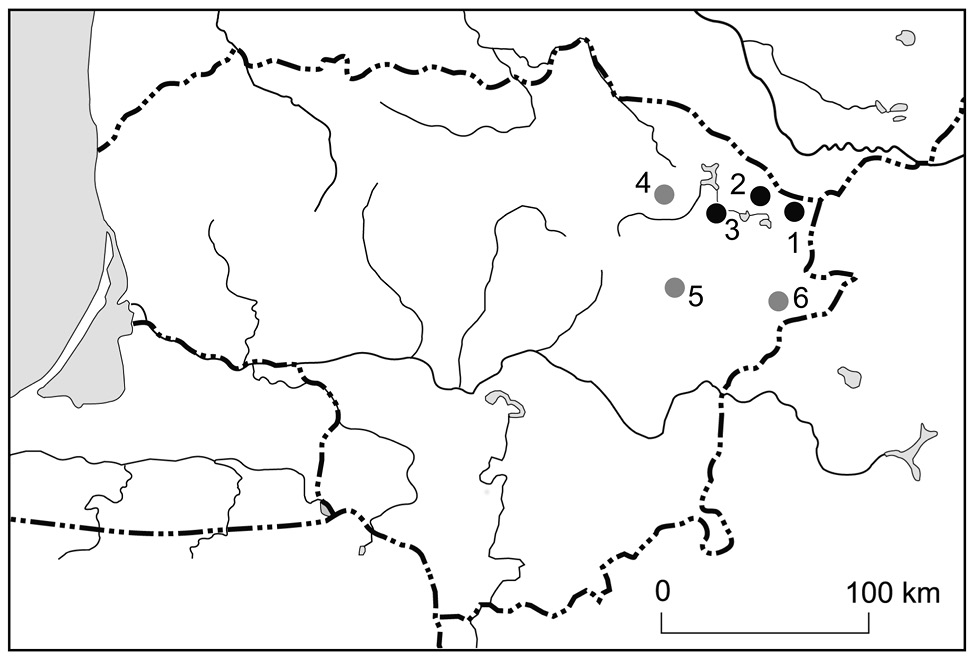
Fig. 1. Bronze Age sites with bone and antler artefacts in Lithuania. Black dots – sites studied in the present resaerch. Grey dots – sites studied in Luik & Maldre 2007. 1 – Sokiškiai, 2 – Mineikiškės, 3 – Garniai I, 4 – Kereliai, 5 – Narkūnai, 6 – Nevieriškė. Map by Kersti Siitan.
1 pav. Lietuvos bronzos amžiaus gyvenvietės, kuriose rasta kaulo ir rago dirbinių. Juodais taškais pažymėtos šioje publikacijoje analizuotos gyvenvietės. Pilki taškai – gyvenvietės, kurių radiniai aptarti ankstesnėje publikacijoje (Luik & Maldre 2007). 1 – Sokiškiai, 2 – Mineikiškės, 3 – Garniai I, 4 – Kereliai, 5 – Narkūnai, 6 – Nevieriškė. Iliustracijos autorius Kersti Siitan
In the meantime, new archaeological excavations have been carried out in Lithuanian Late Bronze Age sites, and 14C AMS dates have been made from both the material collected during the new excavations and the finds of previous excavations (Minkevičius et al., 2020; Podėnas, 2020; Šmigelskas, 2018; Pranckėnaitė, 2012). This has made it possible to refine the dating and chronology of the settlements. Bone artefacts were also found during the new fieldwork. The project “Late Bronze Age (1100–500 BC) economy in the eastern Baltic region: towards a new model” made it possible to study both bone objects found during new archaeological excavations and also the previously unstudied finds from Sokiškiai in 2021.
The present article can be considered as a continuation of the research published in 2007 and therefore it is not necessary to re-present an overview of previous research on Bronze Age bone artefacts as well as the discussion about the role of technology in societies published there (Luik & Maldre, 2007, p. 5–6). However, new studies have been published since, which are mentioned and referred to in this work.
Fortified settlements discussed in the article
This article discusses osseous artefacts and processing waste found in the three fortified settlements. All of them are in the north-eastern part of Lithuania, ca. 20 to 27 km apart from each other as the crow flies (Fig. 1: 1–3). The number of finds in these settlements varies greatly, one reason for that could be that they have been investigated to varying degrees, but the formational processes of the sites also contribute to the number of finds.
The settlement of Sokiškiai is in the Ignalina district municipality, on the shore of Lake Samanis. Archaeological excavations, led by Elena Grigalavičienė took place there from 1980 to 1983, an area of 1115 m2 was investigated, a total of 15 trenches of different size in the northern, western, and central parts of the settlement (Grigalavičienė, 1986, p. 89–91, fig. 1–3). This collection includes about 500 bone artefacts and waste pieces. Mineikiškės is in the Zarasai district municipality, on the left bank of the Nikajus River. In 2017, an area of 10 m2 was excavated there, and in 2020, an area of 30 m2 east and south of the previous excavation plot was investigated (Podėnas, 2018; 2020; Minkevičius, 2021). The total size of the excavated area was 40 m2, 58 bone artefacts and fragments were found. The settlement of Garniai I is in the district municipality of Utena. In 2016, 24 m2 were excavated there and in 2017, another 48 m2 (Čivilytė et al., 2017; Podėnas et al., 2018). The total studied area is 72 m2, the finds include 57 bone artefacts and fragments.
In total, more than 600 osseous artefacts and processing waste pieces from these three sites are stored in the collection of the Lithuanian National Museum. Among them, also such bones and fragments are that do not have any processing traces and are therefore not considered in this analysis. Part of the finds from Sokiškiai are in the museum’s exposition and it was not possible to examine them further. However, also the published finds have been used in both statistics and analysis.
As mentioned above, new 14C AMS dating have recently been made from Lithuanian, as well as other eastern Baltic fortified settlements, most of which have calibrated between 800 and 400 BC, the so-called Hallstatt Plateau (Podėnas, 2019; Podėnas et al., 2022).
Animal bones in fortified settlements
The settlements contained well-preserved and abundant faunal remains. In Mineikiškės and Garniai I, 7952 and 2432 specimens were found respectively, and 8731 specimens were identified in Sokiškiai (Table 1) (Данилченко, 1983). Mammal bones predominated and contained 90.0–99.9% of all faunal remains in all the studied sites However, the situation at Mineikiškės is somewhat exceptional, with a relatively high number of fish (310 pieces, 3.6%), as well as mussel shells. From there 500 shell fragments were collected, representing 6.3% of the total faunal remains. However, the mollusc assemblage should be higher, as not all small shell fragments were collected during the excavations so far. Mussels were also found at Garniai I site, but they were very poorly preserved and could not be collected. However, at Garniai I they were much less abundant than at Mineikiškės. Molluscs were also found in other fortified sites in eastern Lithuania, e.g., in Narkūnai. However, in general they were not collected during the excavations, only a few single shells were found among other finds stored in the National Museum of Lithuania. This indicates that the mussels were consumed at other LBA sites in eastern Lithuania as well. Consumption of mussels is a unique feature not only for Lithuanian LBA sites, but in the Eastern Baltic area in general, where molluscs were not a common food source and are rarely found in prehistoric archaeological material. Only Rinnukalns site in Latvia is famous for its abundance of molluscs so far (Bērziņš et al., 2014).
Table 1. Taxonomic distribution of animal remains from Mineikiškės, Garniai I and Sokiškiai sites. NISP – number of identified specimens. Data for Mineikiškės and Garniai I – this study, and data for Sokiškiai from (Данилченко, 1983)
1 lentelė. Gyvūnų liekanų rūšinis pasiskirstymas Mineikiškių, Garnių I ir Sokiškių įtvirtintose gyvenvietėse. NISP – identifikuotų kaulų skaičius. Mineikiškių ir Garnių I duomenys – ši publikacija, Sokiškių duomenys – iš Данилченко 1983
|
Species |
Mineikiškės |
Garniai I |
Sokiškiai |
|||
|
NISP |
%, NISP |
NISP |
%, NISP |
NISP |
%, NISP |
|
|
Cattle Bos taurus |
165 |
8.4 |
32 |
6.0 |
1875 |
21.5 |
|
Sheep Ovis aries |
17 |
0.9 |
2 |
0.4 |
|
|
|
Goat Capra hircus |
4 |
0.2 |
|
|
|
16.2 |
|
Sheep/goat |
652 |
33.2 |
127 |
23.9 |
1413 |
43.0 |
|
Pig Sus scrofa domesticus |
890 |
45.3 |
307 |
57.8 |
3755 |
5.2 |
|
Horse Equus caballus |
104 |
5.2 |
7 |
1.3 |
457 |
1.4 |
|
Dog Canis lupus familiaris |
|
|
1 |
0.2 |
118 |
|
|
Elk Alces alces |
2 |
0.1 |
|
|
406 |
4.7 |
|
Red deer Cervus elaphus |
4 |
0.2 |
|
|
|
|
|
Roe deer Capreolus capreolus |
5 |
0.3 |
|
|
45 |
0.5 |
|
Boar Sus scrofa |
4 |
0.2 |
2 |
0.4 |
248 |
2.8 |
|
Boar/pig |
11 |
0.6 |
2 |
0.4 |
|
|
|
Beaver Castor fiber |
2 |
0.1 |
|
|
183 |
2.1 |
|
Hare Lepus timidus/Lepus europaeus |
54 |
2.7 |
31 |
5.8 |
141 |
1.6 |
|
Bear Ursus arctos |
|
|
1 |
0.2 |
17 |
0.2 |
|
Fox Vulpes vulpes |
29 |
1.5 |
8 |
1.5 |
39 |
0.4 |
|
Eurasian otter Lutra lutra |
3 |
0.2 |
|
|
11 |
0.1 |
|
European pine marten Martes martes |
5 |
0.3 |
1 |
0.2 |
23 |
0.3 |
|
European polecat Mustela putorius |
|
|
2 |
0.4 |
|
|
|
Mustelidae |
4 |
0.2 |
|
|
|
|
|
Red squirrel Sciurus vulgaris |
5 |
0.3 |
2 |
0.4 |
|
|
|
Small rodents |
6 |
0.3 |
6 |
1.1 |
|
|
|
In total |
1965 |
100.0 |
531 |
100.0 |
8731 |
100.0 |
At the Bronze age sites of Lithuania, most of the mammal bones, about 70–90%, are remains of domestic animal bones (Luik & Maldre, 2007, p. 6; Bliujienė et al., 2020) and this is also the case in the sites considered here. For example, in Sokiškiai the share of domestic animal bones is 87% (Данилченко, 1983), and in Mineikiškės and Garniai I 93.8% and 89.7% respectively. Among domestic animals, pig bone fragments were the most abundant in all sites, ranging from 43.0% in Sokiškiai to 57.8% in Garniai I (Table 1). Sheep and goats were the second most abundant group in Mineikiškės and Garniai I (34.4% and 23.9% respectively). Fewer were found in Sokiškiai (16%), where the share of cattle remains in this site was higher (22%) than in the other two, where cattle was represented only with 6–9.4%. The proportion of horses in the settlements is even much lower.
The share of domestic animals is broadly similar in eastern Lithuanian Bronze Age sites, with pig bones and small ungulates in general being the most numerous. In contrast, zooarchaeological material from western Lithuania presents an entirely different picture with predominating cattle and horse remains. Thus, populations in eastern and western Lithuania during the Late Bronze Age followed somewhat different animal husbandry strategies (Bliujienė et al., 2020).
Bones of wild animals are scarce in all sites, accounting for 7–12% of the mammal bones found. Both small and large wild animals are represented – hare, fox, marten, elk, bear, red squirrel and others (Table 1). The occurrence and proportion of species varies from site to site, for example, Sokiškiai has the highest number of elk, wild boar, and beaver bones (Данилченко, 1983). Garniai I and Mineikiškės are represented by more hare and fox bones, while elk and other large ungulates are very few. This is a completely different situation comparing to the Stone Age sites in eastern Lithuania, where zooarchaeological material was dominated by the remains of large ungulates, mainly elk and red deer (Piličiauskas et al., 2020, and authors mentioned here). This may have been caused by the peculiarities of butchering and transporting the hunted large game, as meat may have reached the settlement site already after filleting. In Sokiškiai, however, the remains of large game were the most abundant among the wild animals, with elk and wild boar bone fragments accounting for 7.5% of the total, while hares, foxes, and pigs were found in small numbers.
We would attribute the specificity of the Sokiškis settlement and the tendency for finding larger animal remains to a few possible reasons. One of them may be the possible admixture of Roman Period material in Sokiškai. The second and probably the most likely is the methodology of archaeological excavations. During the archaeological research in 1980–1984, the bones were collected by hand, whereas in Mineikiškės and Garniai I sieving was used. V. Danilchenko, who studied the remains of the Sokiskis fauna, also noted in her report that the bone fragments are large (Данилченко, 1983). Meanwhile, the bone fragments in other two sites are extremely small, the average weight of a mammal bone fragment ranges from 1 to 1.7 g. Taking into account the character of the bone fragmentation and butchering marks, it can be suggested that the bones of the animals were merely smashed, crushed and then probably cooked during the preparation of food, thus obtaining the maximum possible extraction of the fat and marrow in the bones. Animal bones chopped up in this way are quite exceptional in Lithuanian zooarchaeological material. Excluding the impact of later taphonomic processes, the faunal remains from other periods in Lithuania are generally less fragmentary. May that be related to a particular shortage of protein food during the Late Bronze Age? The nontraditional consumption of mussels could also support such a presumption. However, more detailed faunal and dietary studies of the period and area discussed are needed to support or reject this hypothesis.
Overview of the used materials and artefact types by sites
Most of the artefacts and processing waste are of bone, there are significantly fewer antlers and only a few teeth with working traces (Table 2). As part of the objects from Sokiškiai were on the exhibition and it was not possible to examine and determine these finds, some of the numbers in the following overview are approximate.
Table 2. Identified materials of artefacts and processing waste
2 lentelė. Identifikuota dirbinių ir gamybos atliekų žaliava
|
Material |
Sokiškiai |
Mineikiškės |
Garniai I |
Total |
|
Bone |
~360 |
49 |
22 |
~430 |
|
Antler |
44 |
8 |
1 |
53 |
|
Teeth |
5 |
1 |
– |
6 |
|
Total |
~400 |
58 |
23 |
~500 |
Sokiškiai
In the hillfort of Sokiškiai, finds were located unevenly. Most of them were obtained from excavation areas located on the edges of the hill, where the cultural layer was thicker, only a few items were found in the central part of the hill. Although the total number of bone and antler objects is mentioned to be more than 500 (Grigalavičienė, 1986, p. 101–102, 136), only about 400 finds can be considered as artefacts and processing waste, as there are many unworked bones and teeth among the finds.
There are five worked teeth, including a bear canine pendant, two boar tusk pendants, a scraper made of boar tusk and a boar tusk with a cut end. The number of worked antler pieces is 44, some of which are elk antlers, but in most cases, it is not possible to determine whether an elk or a red deer antler has been used. There are about two dozen antler artefacts, including 15 pins, one pointed item (awl?), three broken handles, and some unidentified antler tools and unfinished items. Eighteen antler pieces, including seven fragments glued together, can be considered as unused raw material or production waste.
There are about 360 bone objects and processing waste pieces. Among the bone artefacts and waste determined to the species level the most numerous are the bones of domestic animals – pigs and goat/sheep. Goat, sheep, and pig bones are undoubtedly represented also among bone objects material of which was not possible to be determined. Many bone artefacts can only be identified as made of large ungulate bone; probably bovine bones are the most numerous among them.
There are a total of 70 objects and fragments of pig bones. The most numerous among them are fibulae (34), followed by tibiae (24), the other skeletal parts are represented only with a few or a single specimen: humerus (in 5–6 cases), femur (3–4), radius (2) and rib (1). There are 48 objects of goat/sheep bone, including three definitely sheep bones. Among them, the most numerous are metapodium bones, a total of 28, of which at least 14 are metatarsals and six are metacarpals. In 16 cases, tibiae were used. On one occasion, the humerus, femur, and radius were identified.
Much less was possible to identify in the case of the bones of wild animals. Elk metapodium bones have been used at least in five cases and presumable wild boar bones also in a few cases. In one case it was possible to determine the metapodium bone of a carnivore (dog, wolf or lynx?). There are also a few artefacts from the bones of smaller wild animals, including one fox radius and four hare bones (two tibias, one ulna and one humerus). One object is made of a bird bone, but the species and skeletal part could not be determined.
Chisels and scrapers with more than 100 specimen are the most numerous artefact types. Awls and other points are represented with about 90, and pins with about 80 finds. There are about a dozen spearheads, other objects are represented only with a few examples – some items made of ribs, two presumable daggers, an arrowhead, and a disc made of scapula. The remaining about half a hundred finds are unidentified fragments, blanks, and production waste.
Mineikiškės
In the settlement of Mineikiškės, 58 artefacts and fragments of osseous materials have been found, which are recorded under 52 inventory numbers (one inventory number covers seven antler pieces from one object). Although the bone objects were not evenly distributed in the excavated area, it was not possible to identify a specific area of concentration; however, most of the bone artefacts were located up till the first line of the enclosure (Podėnas, 2020; Minkevičius, 2021).
Of the objects from osseous materials, 49 are bone and eight are of elk or red deer antlers (including seven fragments of one object), in one case a tooth has been used (as a pendant). Of the domestic animals, goat/sheep, pig, and cattle are represented among the worked bone material. In nine cases, pig bones have been used (four fibulae, two tibiae, one humerus, one metapodia and one tusk). There are six goat/sheep bones: five metapodium bones (one of which is metatarsus) and one tibia. Of the bovine bones, one ulna can be determined. In the case of wild animals, a fox ulna has also been identified in addition to the abovementioned antler objects. Most of the finds are fragmentary and can be identified only as a long bone of a small or large ungulate (in 6 and 15 cases, respectively), or just as a fragment of a tubular bone (4), some small fragments remained undetermined. Pins are the most numerous artefact type with 18 specimens, including also a pin made of antler. Altogether 13 awls and points have been found, and at least 11 chisels and scrapers. Three objects may be spearheads, but it is not certain – since their tip is broken, they could also have been chisels. The seven antler fragments found together may be pieces of an unfinished handle. There are also a few fragments of unspecified objects.
Garniai I
In the settlement of Garniai I, 57 bone items and fragments have been found, which are listed under 35 inventory numbers. Of the animal species, seven goat/sheep bones (three metapodia, tibia, femur, mandible, and vertebra cervical), three pig bones (all fibulae) and one cattle bone (femur head) are identifiable. Eight bones are long bones of small ungulates and two of large ungulates. In one case presumably a long bone of a hare is used. Most of the finds are small fragments and a part of them, including a tooth, were probably not worked. At least 23 finds can be considered as artefacts. Only one object – a double button – is made from antler, all the others are from bone. The most numerous are awls or other points – a total of eight fragments of seven artefacts. Two objects are chisels and two are pins, one of them is broken at the hole in its head, the other is just a small fragment. In the case of the nine fragments with working traces, it is not clear from which objects they originate.
In summary, different types of objects are represented in very different numbers among the finds of these three sites (Table 3). The most numerous are chisels and scrapers and pointed items. There are various types of such objects, including specimens of different sizes and shapes. The third most numerous find type is bone pins. The other artefact types are represented in significantly smaller numbers. In addition to artefacts, processing waste is also represented. As at the other fortified settlements in the eastern Baltic region, the bone artefacts have been made mostly of bones of the animal species that were also used for food.
Table 3. Artefact types. In the case of types with a large number of finds, including fragments which cannot be identified as a particular type, the table gives approximate numbers
3 lentelė. Dirbinių tipai. Tais atvejais, kuomet buvo aptikti dideli radinių ir tiksliau neklasifikuojamų jų fragmentų kiekiai, yra nurodomas apytikslis skaičius
|
Artefact type |
Total |
|
Chisels and scrapers |
>120 |
|
Awls and points |
>110 |
|
Pins |
>100 |
|
Spearheads |
>10 |
|
Handles |
3 |
|
Knives and rib tools |
3 |
|
Daggers |
2 |
|
Arrowheads |
2 |
|
Disc |
1 |
|
Rib plate |
1 |
|
Antler double button |
1 |
|
Tooth pendants |
4 |
|
Tooth items |
2 |
Teeth objects
Although a number of teeth and canines have been picked up among artefacts, most of them are unworked, or fragments in which case it is not possible to know if they have been processed or used. Here we take a closer look at only those teeth that were certainly worked. There are six such teeth in total.
Teeth and canines were most often used as pendants. Pendants are usually interpreted as protective amulets, but they were also worn as jewellery and, when placed side by side in the necklace, could make sounds when moving and dancing (e.g., Mannermaa & Rainio, 2014). Tooth pendants could also have meanings expressing status or identity (e.g., Jonuks & Rannamäe, 2015, p. 20).
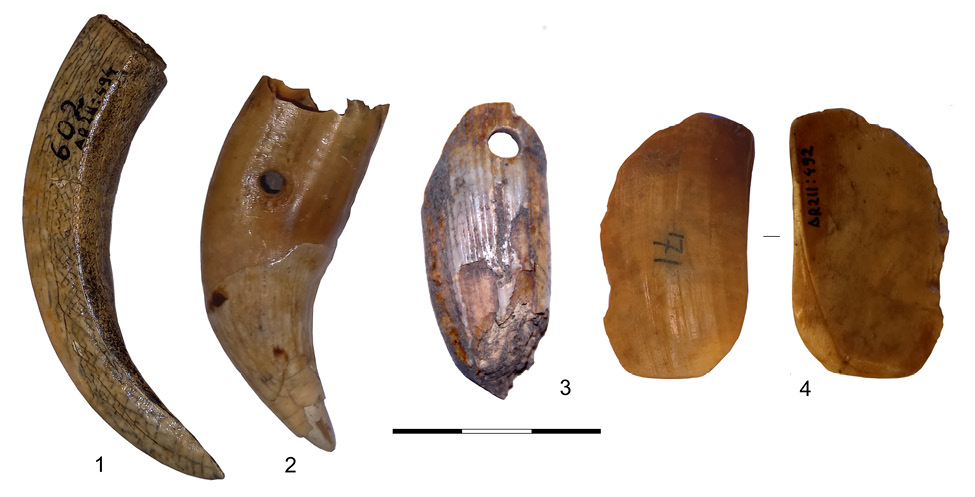
Fig. 2. Teeth artefacts from Sokiškiai (1–2, 4) and Mineikiškės (3). 1 – pig tusk with cut end (LNM AR 211: 494); 2 – bear canine pendant (LNM AR 211: 493); 3 – pig tusk pendant (LNM Mnk 20: 256); 4 – scraper made of pig tusk (LNM AR 211: 492). Photos 1–2, 4 by Heidi Luik, 3 by Vytenis Podėnas.
2 pav. Dirbiniai iš dantų Sokiškėse (1–2, 4) ir Mineikiškėse (3). 1 – kiaulės iltinis dantis nukirstu galu (LNM AR 211: 494); 2 – kabutis iš meškos iltinio danties (LNM AR 211: 493); 3 – kabutis iš kiaulės iltinio danties (LNM Mnk 20: 256); 4 – gremžtukas iš kiaulės iltinio danties (LNM AR 211: 492). Heidi Luik (1–2, 4) ir Vytenio Podėno (3) nuotraukos
A fragment of a boar tusk pendant has been found in Mineikiškės (Fig. 2: 3; Minkevičius, 2021, fig. 49: 256), two boar tusk pendants, one with a hole and another with a notch, and also a bear canine pendant have been found in Sokiškiai (Fig. 2: 2; Grigalavičienė, 1986, fig. 23: 7, 9, 11; 1995, fig. 111: 5–6, 9). In the case of one boar tusk from Sokiškiai, the root end of the tusk has been cut straight and a small step is formed there (Fig. 2: 1), the purpose of the object is unknown. A small scraper made of boar tusk has also been found in Sokiškiai (Fig. 2: 4). There are more pig teeth among the finds from Sokiškiai, but these are without holes or other traces of processing.
Tooth pendants and other objects made from teeth are few among the Late Bronze Age finds in the eastern Baltic region. Some tooth pendants and worked teeth and tusks are also known from other fortified settlements in eastern Lithuania and also in north-western Byelorus (Grigalavičienė, 1995, fig. 111; Егорейченко, 2006, pl. 35–36, 37: 3; Luik & Maldre, 2007, p. 14–15, fig. 14). In Latvia, some tooth pendants have been found from the fortified settlement site and cemetery in Ķivutkalns (Денисова et al., 1985, fig. 33: 8, 14; Graudonis, 1989, pl. XXV: 13–15). In Estonia some boar tusk and bear canine pendants are known from Iru, but since both a Late Bronze Age settlement site and a Viking Age hill fort have been located there at the same place, these finds cannot be dated to the Bronze Age with any certainty. However, at least one of them has been associated with the Late Bronze Age fortified settlement based on the find context (Lang, 1996, pl. VII: 5). Boar tusks with two holes, which could have been pendants or were sewn on the clothing, have been found from the grave dated to 900–750 BC in Przeczyce, Poland (Baron et al., 2022), and some pendants made of horse incisors have been found from Sobiejuchy (Harding et al., 2004, p. 64, pl. 28: 36–37). However, compared to the Neolithic, tooth pendants are a rather rare artefact type in the Late Bronze Age (Luik et al., 2011, p. 251 ff., and references there).
Antler artefacts and working waste
There are at least 53 antler objects and fragments with working traces among the finds of the discussed settlements (Table 2). The antler pieces that can be determined are elk antlers, but in most cases it is not possible to determine the species. Most of them, 44 have been found in Sokiškiai. Among the objects examined this time are two fragments of handles, one of them with grooves, and among the published finds there is another fragment of a handle, which could presently not be studied in the museum (Fig. 3: 3–4; Grigalavičienė, 1986, fig. 19: 3, 23: 13; 1995, fig. 61: 5, 8–9; Егорейченко, 2006, pl. 26: 1–2). There are also some antler pins, at least 15. The exact number is not known, because some of the pins were in the museum’s exhibition and it was not possible to determine the material used to make them. Most antler pins are simple specimens with a thickened or nail-shaped head (Fig. 3: 1). In the case of seven antler objects, their function is not clear; some of them are unfinished objects or blanks. One large antler object has a wedge-like end, the other end has working traces, it may have been an unfinished or recycled item (Fig. 4: 4). The wedge-shaped end of the object is similar to the hoe or ard points known from the Late Bronze Age settlements in Latvia and Estonia (Luik & Lang, 2013), but the other end, with traces of processing, would be too narrow to make such an object. One of the mentioned handles is probably also an unfinished object (Fig. 3: 4). There are production wastes of 13 inventory numbers, including seven antler pieces glued together (Fig. 4). Some antler tips with working traces may be blanks for double buttons, although it cannot be ruled out that they are just production waste (Fig. 4: 6–7). A few narrow antler strips can be blanks for making pins (Fig. 4: 1, 3). Working traces visible on production waste are discussed below together with processing traces on bone objects.
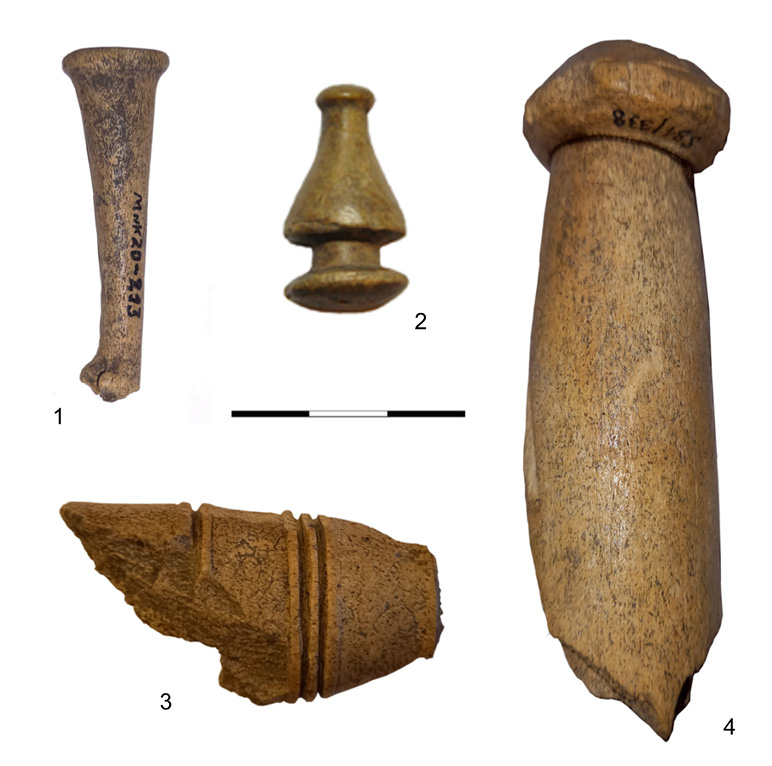
Fig. 3. Antler artefacts from Mineikiškės (1), Garniai I (2), Sokiškiai (3–4). 1 – fragment of a pin (LNM Mnk 20: 213); 2 – double button (LNM AR 997: 3); 3, 4 – fragments of handles (LNM AR 211: 505, 308). Photos 1–2 by Vytenis Podėnas, 3–4 by Heidi Luik.
3 pav. Rago dirbiniai iš Mineikiškių (1), Garnių (2), Sokiškių (3–4). 1 – smeigtuko fragmentas (LNM Mnk 20: 213); 2 – dviguba sagutė (LNM AR 997: 3); 3, 4 – rankenų fragmentai (LNM AR 211: 505, 308). Vytenio Podėno (1–2) ir Heidi Luik (3–4) nuotraukos
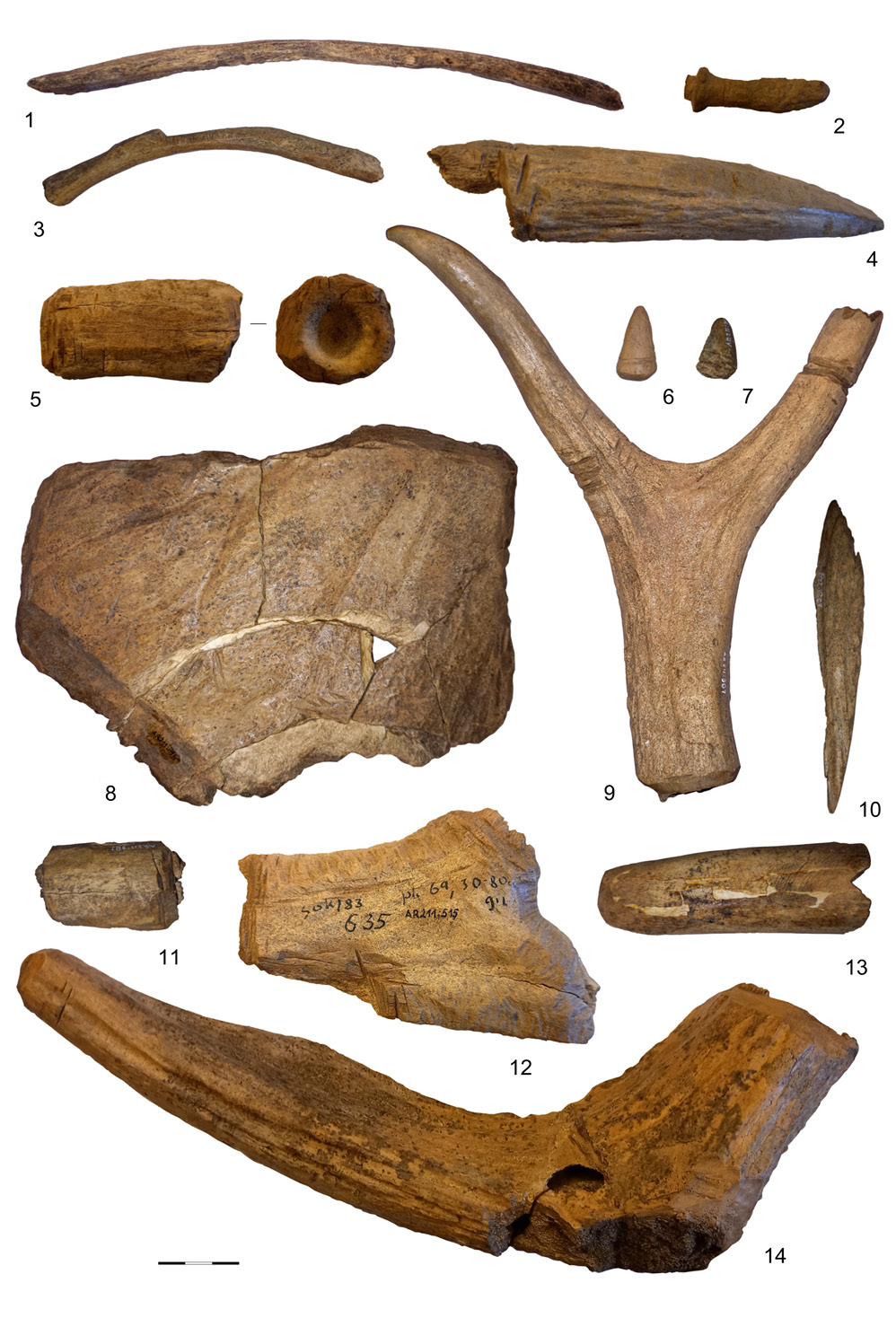
Fig. 4. Antler waste from Sokiškiai (LNM AR 211: 490, 497, 115, 514, 192, 166, 388, 194, 387, 359, 382, 515, 374, 516). Photos by Heidi Luik.
4 pav. Rago apdirbimo atliekos iš Sokiškių (LNM AR 211: 490, 497, 115, 514, 192, 166, 388, 194, 387, 359, 382, 515, 374, 516). Heidi Luik nuotraukos
Among the finds from Mineikiškės are eight antler fragments under two inventory numbers. One of them is the already mentioned fragmentary pin (Fig. 3: 1; Minkevičius, 2021, fig. 38: 213). The seven antler fragments under another inventory number originate from an unfinished object with a hollow in the middle (Minkevičius, 2021, fig. 42). Presumably they come from a similar hollow antler item as one unfinished object found in Sokiškiai (Fig. 4: 5; Grigalavičienė, 1995, fig. 61: 14), both of which may be handle blanks. Only a single antler artefact is known from Garniai I – a small double button (Fig. 3: 2).
It is remarkable that about half of antler objects are unfinished items or working waste pieces, and the finished objects are relatively few. Another reason why more waste pieces are found could also be the usage of sieves at more recent excavations, which also allows for smaller waste pieces to be found. Still, the same can be observed for the previously studied fortified settlements of Narkūnai, Nevieriškė and Kereliai (Luik & Maldre, 2007, p. 12 ff., fig. 4 ff.). In Estonia and Latvia, especially in Asva and Ķivutkalns, antler artefacts are more numerous. This may partly be due to the types of antler artefacts, which are relatively abundant at these settlements (Luik, 2011, fig. 6), but which are less frequent or absent in Lithuania. In Asva and Ķivutkalns, as well as in some other settlements in Estonia and Latvia, antler hoe or ard points have been found, which are not represented among the finds of the sites discussed here (Graudonis, 1989, pl. XIIa, XLII: 12; Luik & Lang, 2011; Luik, 2013, p. 393, fig. 7; Sperling et al., 2015, p. 59, fig. 12: 4). Here, also no antler points with spiral use wear, cheek pieces of horse harness, harpoons, and spoons have been found, but which have been documented in the fortified settlements of Estonia and Latvia (Graudonis, 1989, pl. XXVI: 6–7; Lang, 1996, pl. VIII: 1–2, 5; Luik, 2010; 2011; 2013, p. 395 ff., fig. 9–10, 14; Sperling et al., 2021, p. 60–61, fig. 10). Antler handles are also more numerous among the finds of Latvian and Estonian sites (Graudonis, 1989, pl. XIV–XV; Luik, 2011, p. 42–43, fig. 7; Sperling et al. 2021, p. 59, fig. 7: 2–3). There is also considerably more antler processing waste in Ķivutkalns and Asva than in the Lithuanian settlements considered here (Graudonis, 1989, fig. 23, pl. XI–XV, XLII; Luik, 2011, fig. 2–4). The antler double button found in Garniai I is the only representative of this type of object among the finds discussed here. Although double buttons are not very numerous also elsewhere, they are still more common both in Asva (Luik & Ots, 2007, fig. 4: 1, 4–7; Sperling et al., 2015, p. 59, fig. 12: 1), and Ķivutkalns, where similar amber buttons are also known (Graudonis, 1989, pl. X: 1–6, XXV: 19–21). Of course, the number of objects found also depends on the size of the investigated area. However, only one or a few buttons have also been found at several sites in Lithuania, Byelorus, and Estonia (Grigalavičienė, 1995, fig. 100: 1–3; Егорейченко, 2006, pl. 34: 2–4, 6–7; Luik & Ots, 2007, fig. 4: 3; Luik & Maldre, 2007, fig. 9). Antler pins are also rather rare; most pins are made from the diaphysis of large long bones (Lang & Luik, 2022).
Bone artefacts and working waste
Bone artefacts are mostly made of tubular bones. In some cases, the object is made of a whole bone, only by cutting or sharpening its end, in which case the animal species and the skeletal part can be determined. Alternatively, the object is made from the diaphysis of a large tubular bone, in which case it is usually not possible to determine the species or bone more precisely. Of the bone tools, the most numerous are various chisels and scrapers with a narrower or wider blade, as well as various awls or other points. Bone pins and their fragments are also common. As only the sharp tip of the artefact is sometimes preserved, it is not always clear whether it comes from a pin or an awl. The spearheads are represented by more than a dozen finds, but there are also specimens with a broken tip, in which case it is not certain whether it was a spearhead or a chisel-like object. Of the other artefact types, only one or a few specimens are known (tools made of ribs, daggers, arrowhead, bone disc).
Chisels and scrapers
The most numerous types of bone objects are chisels and scrapers, about 125 specimens altogether, quite a large portion, of which a part has been preserved fragmentarily (Grigalavičienė, 1986, fig. 17, 18: 1, 19: 4, 6–7, 9; Minkevičius, 2021, fig. 40). There are tools made of a whole tubular bone, in which one of the bone epiphyses forms a handle or socket (Fig. 5: 7–11), as well as tools made of a piece of long bone diaphysis, which had to be fixed inside the handle for use (Fig. 5: 1–6). Some of the last mentioned objects are wider at one end and are chisel-shaped, and are narrower and sharper at the other end. It is possible that the blade could be placed in the handle in different ways so that it was possible to use a different end for different tasks (e.g., fig. 5: 2; Graudonis, 1989, pl. XIX: 11; Luik & Maldre, 2007, fig. 23: 3). The shape of the ends of chisel-like objects can be different – square, oval or round and can also be of different widths. The cross-section of the blade is more often symmetrically V-shaped, but can also be asymmetrical, so that one side is straight and the other is oblique (cf. different cross-sections: Grigalavičienė, 1986, fig. 17).
In the case of the better preserved chisels and scrapers, which can be identified to the species level and skeletal part, the specimens made of pig tibia are most common (22 chisels) (Fig. 5: 9–11). Some similar tools are made also from other pig bones: radius (2), femur (3) and humerus (5) (Fig. 5: 8). Some small chisel-like tools made of pig fibula have been found from Sokiškiai (Fig. 5: 12–13; Grigalavičienė, 1996, fig. 18: 1). A similar chisel made of pig fibula is also known from Brikuļi, Latvia (Vasks, 1994, pl. VI: 14). Nine chisels were identified as made from goat/sheep bones, six of which are of tibiae (Fig. 5: 7), and one of the radius, one of the humerus, and one of the metatarsus. Since three of them have a broken tip, it is not certain whether it was a chisel or a spearhead. In two cases, the tool with a chisel-like end is made of elk metapodium (Fig. 5: 3). As mentioned above, there are also a few chisels or scrapers made of tooth and antler.
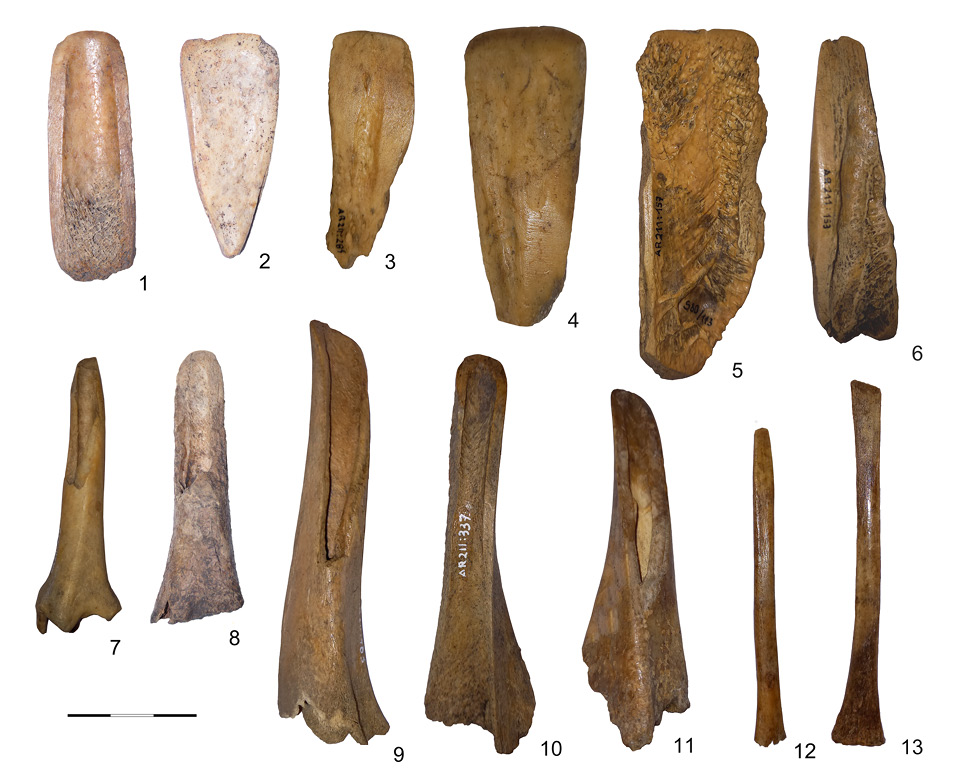
Fig. 5. Bone chisels and scrapers from Mineikiškės (1–2, 8) and Sokiškiai (3–7, 9–13). Materials: 1–2, 4–6 – large ungulate long bone; 3 – elk metapodia; 7 – sheep/goat tibia; 8 – pig humerus; 9–11 – pig tibia; 12–13 – pig fibula (LNM Mnk 20: 247, 251, LNM AR 211: 284, 281, 157, 153, 339, LNM Mnk 20: 224, LNM AR 211: 463, 337, 331, 299, 294). Photos 1–2, 8 by Vytenis Podėnas, 3–7, 9–13 by Heidi Luik.
5 pav. Kauliniai kalteliai ir gremžtukai iš Mineikiškių (1–2, 8) ir Sokiškių (3–7, 9–13). Žaliava: 1–2, 4–6 – stambių kanopinių gyvūnų ilgieji kaulai; 3 – briedžio metapodija; 7 – avies / ožkos blauzdikaulis; 8 – kiaulės petikaulis; 9–11 – kiaulės blauzdikaulis; 12–13 – kiaulės šeivikaulis (LNM Mnk 20: 247, 251, LNM AR 211: 284, 281, 157, 153, 339, LNM Mnk 20: 224, LNM AR 211: 463, 337, 331, 299, 294). Vytenio Podėno (1–2, 8) ir Heidi Luik (3–7, 9–13) nuotraukos
Various bone chisels and scrapers are the most common tools also at other Lithuanian fortified settlement sites (Luik & Maldre, 2007, fig. 22–25), and also in north-western Byelorus (Егорейченко, 2006, pl. 12–13). These tools are less common in Latvian sites (Graudonis, 1989, pl. XIX; Vasks, 1994, pl. VII: 1–15) and only a few have been found in Estonia (Luik, 2013, p. 392–393, fig. 5–6). Depending on the shape and width of the blade, their function may have been different, it is assumed that such tools were used to process bone and antler, flint, leather, or wood (e.g., Maigrot, 2005, p. 118, 122–123; Christidou & Legrand, 2005, p. 387 ff.; Luik, 2013, p. 393).
Awls and other points
There are also more than 100 awls and other points of different size and thickness, nearly 100 specimens from Sokiškiai (Grigalavičienė, 1986, fig. 15–16) and a total of twenty more from the other two sites (Podėnas, 2020, fig. 41: 32–33; Minkevičius, 2021, fig. 41). Awls and points made of goat/sheep bones are most numerous in Sokiškiai, 29 specimens in total, three of which are definitely sheep bones. The most typical are the awls made of goat/sheep metapodial bones, it was possible to identify 26 such tools, at least 11 of which are definitely metatarsals and six are metacarpals (Fig. 6: 1–3, 6–8). Similar tools have been found also at other fortified settlements in Lithuania, as well as in Estonia, Latvia and north-western Byelorus (Егорейченко, 2006, pl. 11; Luik & Maldre, 2007, fig. 16–18; Luik, 2013, p. 390–391, fig. 2). In the case of such tools, a difference can be observed – while in Lithuania they are mostly made of a longitudinally split bone, in Latvia and Estonia most awls have been made of a whole bone the diaphysis of which has been cut diagonally and the tip sharpened (Luik, 2009; Grigalavičienė, 1986, fig. 15: 6–8; 16: 5–10; Graudonis, 1989, pl. XXII: 7–17). Awls made of longitudinally split bones dominate also in the discussed sites (Fig. 6: 1–3, 6–7), with only a few tools made of a whole bone (Fig. 6: 8).
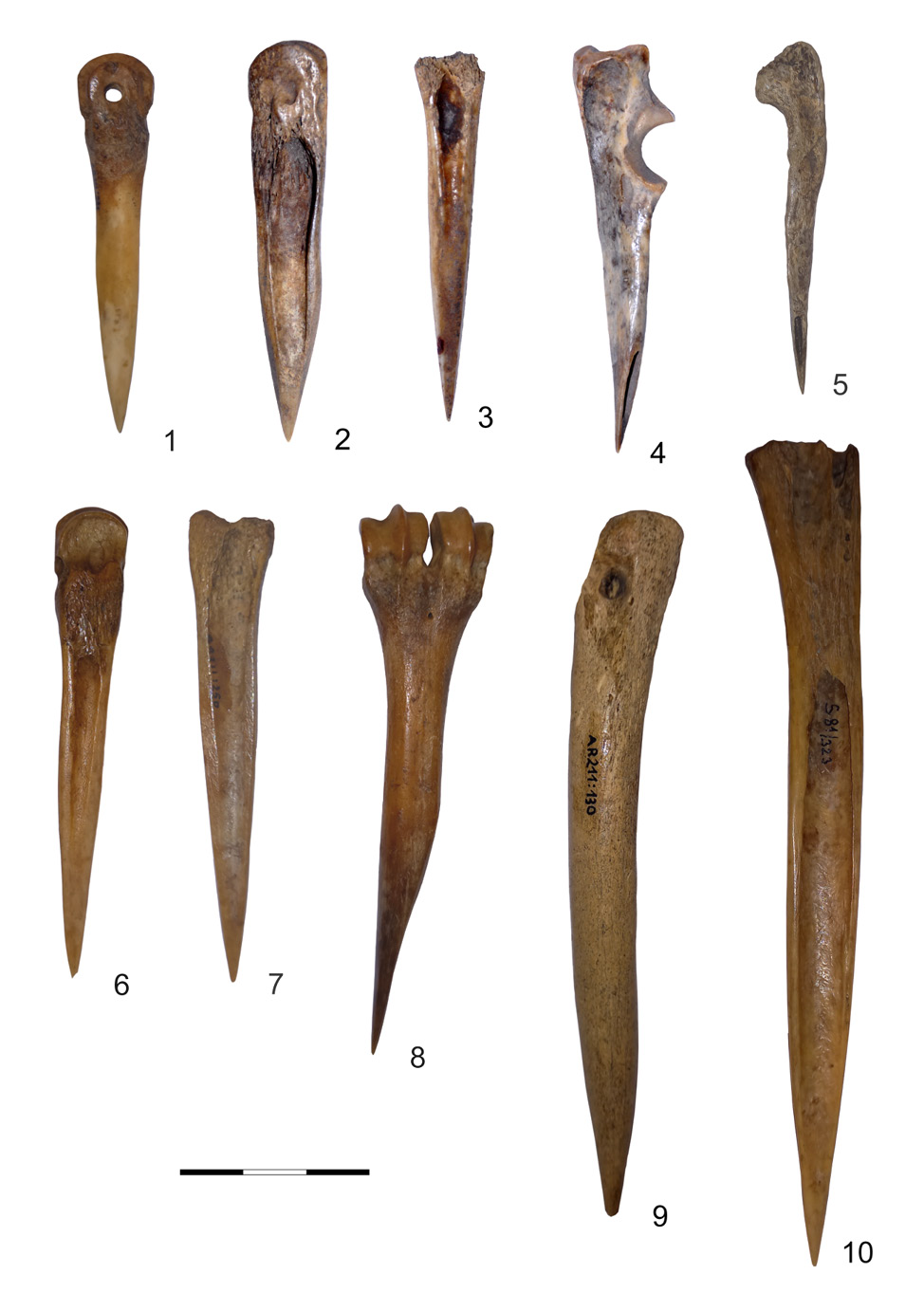
Fig. 6. Bone awls from Sokiškiai (1, 5–10) and Mineikiškės (2–4). Materials: 1, 8 – sheep metatarsus; 2–3, 6 – sheep/goat metapodia; 4 – fox ulna; 5 – hare ulna; 7 – sheep/goat metacarpus; 9 – large ungulate long bone; 10 – sheep/goat tibia (LNM AR 211: 231, LNM Mnk 20: 228, 253, 248, LNM AR 211: 143, 233, 250, 237, 130, 303). Photos 1, 5–10 by Heidi Luik, 2–4 by Vytenis Podėnas.
6 pav. Kaulinės ylos iš Sokiškių (1, 5–10) ir Mineikiškių (2–4). Žaliava: 1, 8 – avies pėdos kaulas; 2–3, 6 – avies / ožkos metapodija; 4 – lapės alkūnkaulis; 5 – kiškio alkūnkaulis; 7 – avies / ožkos plaštakos kaulas; 9 – stambaus kanopinio ilgasis kaulas; 10 – avies / ožkos blauzdikaulis (LNM AR 211: 231, LNM Mnk 20: 228, 253, 248, LNM AR 211: 143, 233, 250, 237, 130, 303). Heidi Luik (1, 5–10) ir Vytenio Podėno (2–4) nuotraukos
Other bones have also been used for making awls and points. At least in three cases goat/sheep tibia was used (Fig. 6: 10) and a pig tibia in one case. There are also awls made from the diaphysis of long tubular bones, in such a case it is usually not possible to identify the animal species and skeletal parts (e.g. Fig. 6: 9). The above-mentioned objects made of wild animal and bird bones (1 metapodium of unspecified carnivore, 4 hare bones, 1 fox bone and 1 bird bone) are also awls and points (Fig. 6: 4–5). Small points from bird and hare bones are also known from other fortified settlements in Lithuania (e.g., Luik & Maldre, 2007, fig. 20: 1–2).
Elk and horse rudimentary metapodial bones were also used for making awls (Graudonis, 1989, pl. XXII: 1–3, 5–6; Luik, 2013, p. 391, fig. 3). There are also points made from ulnae of different animal species, which can be quite massive depending on the size of the bone chosen – such as the points of cattle, horses and elk ulnae (Luik, 2013, p. 392, fig. 4). Smaller points have been made from ulnae of goat/sheep, fox and dog. In the case of the sites discussed here, the point of fox’s ulna was found in Mineikiškės (Fig. 6: 4), and a similar one is known from Narkūnai (Luik & Maldre, 2007, fig. 20: 3).
The points of fox as well as dog ulna are known for example, from Hungary, but they are earlier and date back to the Middle Bronze Age (Choyke, 2005, p. 138, fig. 10: 1–2). Points made from ulnae are more numerous in Latvia, for example, at Ķivutkalns and Vīnakalns (Graudonis, 1989, pl. XXI, XLIII: 11–14). In the case of points of both ulnae and rudimentary metapodium bones, it must be borne in mind that one end of these bones is naturally thinner and that these bones have a rather specific shape, so bones with a broken end are sometimes regarded as tools although is not known whether the tapering end was sharpened or not. Sokiškiai bone objects also include such broken rudimentary metapodium bones and ulnae, which cannot be regarded as tools (e.g., Grigalavičienė, 1986, fig. 15: 12, 17–18).
Some pig fibulae could have been used as awls or points, although these bones were also used as pins for fastening clothes (see below). There are also the so-called ad hoc points – when just a suitable sharp-ended piece of bone diaphysis has been used (Luik & Maldre, 2007, fig. 21). Nevertheless, such random fragments may also have been broken awls.
In summary, the bones selected for awls and points are often of a particularly suitable shape. It is so in the case of goat/sheep metapodial bones, ulnae of several species, pig fibulae as well as elk and horse rudimentary metapodial bones. Such bones have been used for the same purpose at different times and in different regions. The length of the awls and points is also very different, with short specimens likely to be long-used and repeatedly sharpened (Christidou, 2005, p. 96, 98, fig. 3, 12; Luik, 2013, p. 392). This was presumably because the animals were killed rather at certain times of the year, therefore a bone suitable for making an awl may not always have been available and an old tool was used as long as possible (Russell, 2001a, p. 244).
Bone pins
As a large part of Sokiškiai bone pins were in the museum’s exposition, only a part of them could be examined, but additionally also the published pins were considered (Grigalavičienė, 1986, fig. 21–22). In addition to Sokiškiai, pins and their fragments have been found at Mineikiškės (Podėnas, 2020, fig. 41: 1, 14, 31, 40, 50; Minkevičius, 2021, fig. 38) and a couple of fragments at Garniai I. In total, there are about 100 pins and their fragments.
As in other Late Bronze Age fortified settlements, a large group of pins are simple pins made of pig fibula, in which one end of the bone forms the head of the pin, sometimes a hole is made in it, and the other end is cut and sharpened (Fig. 7: 10–11; Graudonis, 1989, pl. XXVII: 1–7; Grigalavičienė, 1995, fig. 99: 2–7; Егорейченко, 2006, pl. 27; Luik & Maldre, 2007, fig. 15; Lang & Luik, 2022, fig. 2: 1–3).
Most pins are made from the diaphysis of the long bones of large ungulates, but as mentioned above, some are also made of antler. The most numerous are the pins with an expanding flat head, sometimes with a hole in it (Fig. 7: 2, 12, 14; Grigalavičienė, 1986, fig. 21: 13–28, 22: 1–6). A better preserved pin from Garniai I also belongs to this type (Fig. 7: 1). Similar pins are known from other Lithuanian sites (Grigalavičienė, 1995, fig. 97), and also from Latvia (Граудонис, 1967, pl. XI: 18; Graudonis, 1989, pl. XXVIII: 27–29; Денисова et al., 1985, pl. 33: 25–26, 28–29).
Pins with a flat widening oval or round head are quite few at the sites discussed here. A couple of such pins are found from Sokiškiai (Fig. 7: 13; Lang & Luik, 2022, fig. 4: 1), and some fragmentary pins come from Mineikiškės (Fig. 7: 8; Minkevičius, 2021, fig. 38: 222, 236). Similar pins are known also from other Lithuanian fortified settlements, for example, Petrešiūnai, Moškėnai and Narkūnai (Grigalavičienė, 1995, fig. 98; Егорейченко, 2006, pl. 31; Luik & Maldre, 2007, fig. 31: 6–7). Such pins are more characteristic to Latvian sites, especially to Ķivutkalns (Граудонис, 1967, pl. X; Graudonis, 1989, pl. XXIX–XXX, XLIV: 3, 4, 9–12; Денисова et al., 1985, pl. 33–34).
Pins with a cylindrical (Fig. 7: 3–4) and nail shaped head have been also found (Grigalavičienė, 1986, fig. 21: 1–8, 12). The above mentioned antler pin from Mineikiškės also belongs to this type (Minkevičius, 2021, fig. 38: 213; Lang & Luik, 2022, fig. 9: 7). Pins with cylindrical heads were spread both in Lithuania, Latvia, Estonia, and north-western Byelorus. Such pins often have an extension with a hole or protruding tabs below the head (Граудонис, 1967, pl. VII–VIII; Graudonis, 1989, pl. XXVIII: 23–26, 33–35; Vasks, 1994, fig. IX: 3–9, 13–14; Grigalavičienė, 1995, fig. 92, 95– 96; Егорейченко, 2006, pl. 28–30; Luik & Maldre, 2007, fig. 31: 1–4; Lang & Luik, 2022, fig. 6, 9).
Also exceptional pins, such as the “shouldered” pin (Fig. 7: 15) and the pin with a serrated head (Fig. 7: 9) have been found at Sokiškiai (Grigalavičienė, 1986, fig. 22: 8–9; 1995, fig. 94: 5, 96: 13). Some pins similar to the last-mentioned pin have been found from Narkūnai (Grigalavičienė, 1995, fig. 94: 3–4; Егорейченко, 2006, pl. 30: 2–3). Pins with a serrated head are also known in eastern Latvia and north-western Byelorus (Vasks, 1994, pl. IX: 1–2; Егорейченко, 2006, pl. 32).
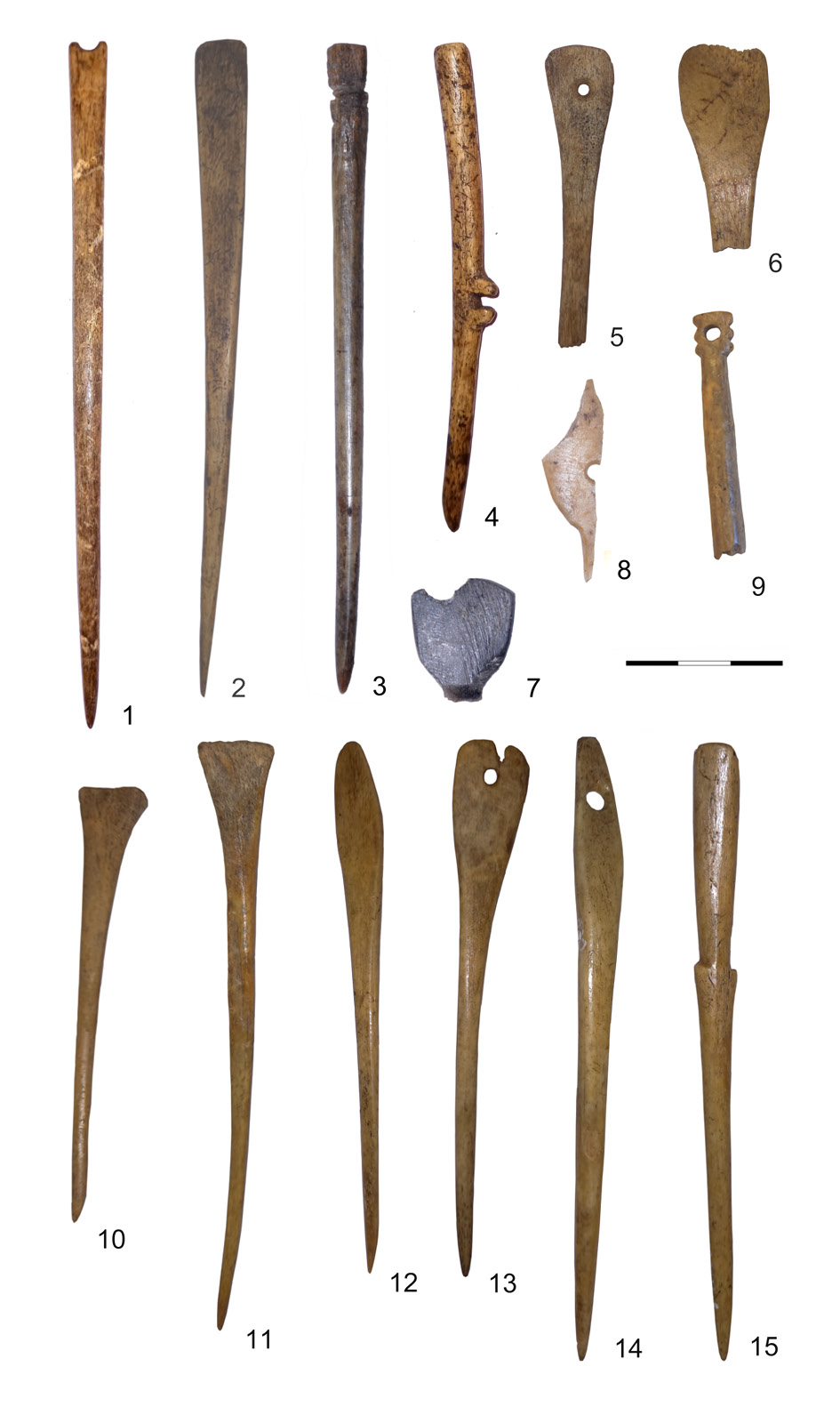
Fig. 7. Bone pins from Garniai I (1), Mineikiškės (2–8), Sokiškiai (9–15). Materials: 1–4, 6–9, 12–15 – large ungulate long bone; 5, 10–11 – pig fibula (LNM AR 997: 17, LNM Mnk 17: 40, Mnk 20: 260, Mnk 17: 31, 1, 14, Mnk 20: 249, 236, LNM 211: 417, 117, 409, 213, 219, 402, 416). Photos 1–2, 4–6, 9–15 by Heidi Luik, 3, 7–8 by Vytenis Podėnas.
7 pav. Kauliniai smeigtukai iš Garnių (1), Mineikiškių (2–8), Sokiškių (9–15). Žaliava: 1–4, 6–9, 12–15 – stambaus kanopinio ilgasis kaulas; 5, 10–11 – kiaulės šeivikaulis (LNM AR 997: 17, LNM Mnk 17: 40, Mnk 20: 260, Mnk 17: 31, 1, 14, Mnk 20: 249, 236, LNM 211: 417, 117, 409, 213, 219, 402, 416). Heidi Luik (1–2, 4–6, 9–1) ir Vytenio Podėno (3, 7–8) nuotraukos
In some cases, the broken ends of pins have been smoothed, so it was possible to use these objects further. Such examples are a pin from Mineikiškės (Fig. 7: 4; Podėnas, 2018, fig. 3; 2020, fig. 41: 31) and one from Garniai I (Fig. 7: 1). The broken tip of the pin from Mineikiškės has been cut smooth similarly to the pin found from Asva. It is possible that after repairing these pins were used as toggles for fastening garments (Lang & Luik, 2022, fig. 10). The pin from Garniai I has been broken at the hole in the head of the pin and the breaking point has been smoothed. Quite numerous are fragments of the tip or shaft of the pin, and it is not known how the head of the pin looked like. The pins could have been very carefully worked, but some are also made quite negligently. One pin from Mineikiškės has a neatly polished shaft, but the head part is cut roughly, presumably it was left unfinished (Fig. 7: 3; Minkevičius, 2021, fig. 38: 260).
Spearheads
17 artefacts among the finds from Sokiškiai could be spearheads (Fig. 8; Grigalavičienė 1986, fig. 20: 8–9, 13–18), nevertheless, some of these are broken (4 altogether) and could have had a chisel-shaped tip as well. Three probable spearheads are also from Mineikiškės, but since their tips are broken, it cannot be certain (Podėnas, 2020, fig. 41: 41; Minkevičius, 2021, fig. 44: 241). Such spearheads are most typical to Lithuanian fortified settlements (Grigalavičienė, 1995, fig. 58–59; Егорейченко, 2006, pl. 15–16, 17: 1, 3; Luik & Maldre, 2007, p. 19–20, fig. 26–28). Some spearheads have been found also from Brikuļi in eastern Latvia (Vasks, 1994, pl. VIII: 3–4), from Estonia only one such spearhead is known from Ridala fortified settlement (Luik, 2013, p. 397, fig. 12). Usually such spearheads have been made of goat/sheep bones. It was possible to identify the material of ten spearheads from Sokiškiai which all are made from sheep/goat bones, nine of which are tibiae (Fig. 8: 3–7) and one is metatarsus. For seven specimens it was only possible to say that these are made of long bone of large ungulate (Fig. 8: 1–2).
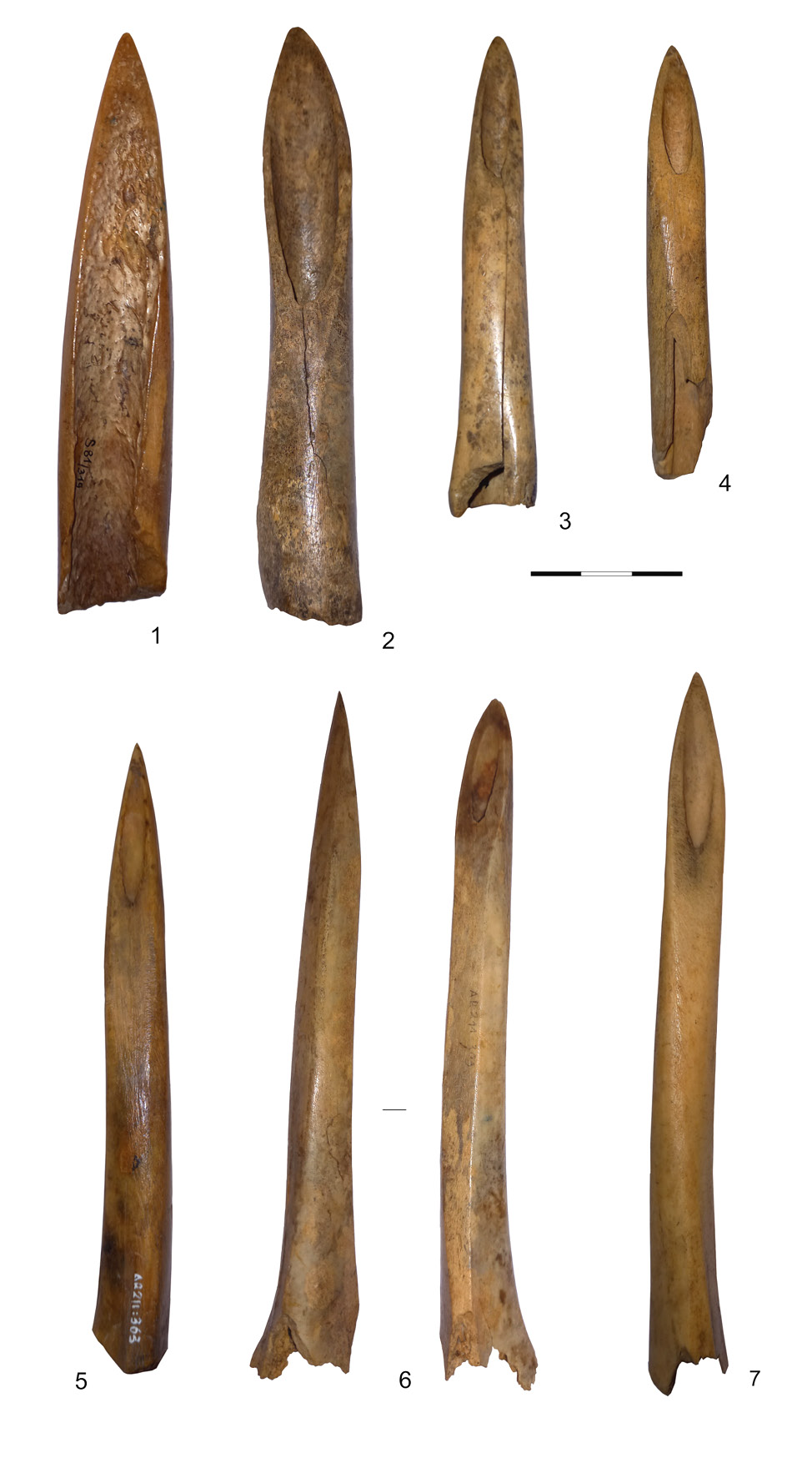
Fig. 8. Spearheads from Sokiškiai. Materials: 1–2 – large ungulate long bone; 3–7 – sheep/goat tibia (LNM AR 211: 508, 165, 483, 304, 363, 309, 302). Photos by Heidi Luik.
8 pav. Iečių antgaliai iš Sokiškių. Naudotos medžiagos: 1–2 – stambių kanopinių ilgieji kaulai; 3–7 – avies / ožkos blauzdikaulis (LNM AR 211: 508, 165, 483, 304, 363, 309, 302). Heidi Luik nuotraukos
Bone knives and objects made of ribs
Thin bone tools with a long sharp edge have been called bone knives (Grigalavičienė, 1986, fig. 18: 14–16; 1995, fig. 75: 3, 5–6; Егорейченко, 2006, pl. 14: 1–3, 5); at least some of them are made from ribs (Fig. 9: 3). Another type of rib tools has an oval or sharpened working end. Similar tools have been found also from other Lithuanian fortified sites (Grigalavičienė, 1995, fig. 75; Luik & Maldre, 2007, p. 20, 22, fig. 29). One quadrangular rib strip with two holes in the middle (Grigalavičienė, 1986, fig. 19: 8) could have been some kind of a decorative plate. Rib has been identified as material for seven objects, one of them was possible to identify as pig’s rib. Rib tools are found also from Latvian and Estonian sites and have been interpreted as tools for working with different materials (e.g., Вассар, 1955, fig. 36: 6; Luik, 2022b, p. 66–68, fig. 7–8).
Daggers
Two long bone objects with a sharp tip have been interpreted as daggers; both are found from Sokiškiai (Grigalavičienė, 1986, fig. 20: 11–12). One of them is made of elk metapodial bone and the other from an unidentified large long bone (Fig. 9: 4–5). One partially worked elk metapodium from Sokiškiai could be a blank for making similar objects. Long massive objects with a pointed tip are found also from other fortified settlements in Lithuania, for example, in Vorėnai, Moškėnai and Kereliai (Grigalavičienė, 1995, fig. 60: 10, 12–13; Luik & Maldre, 2007, fig. 9).
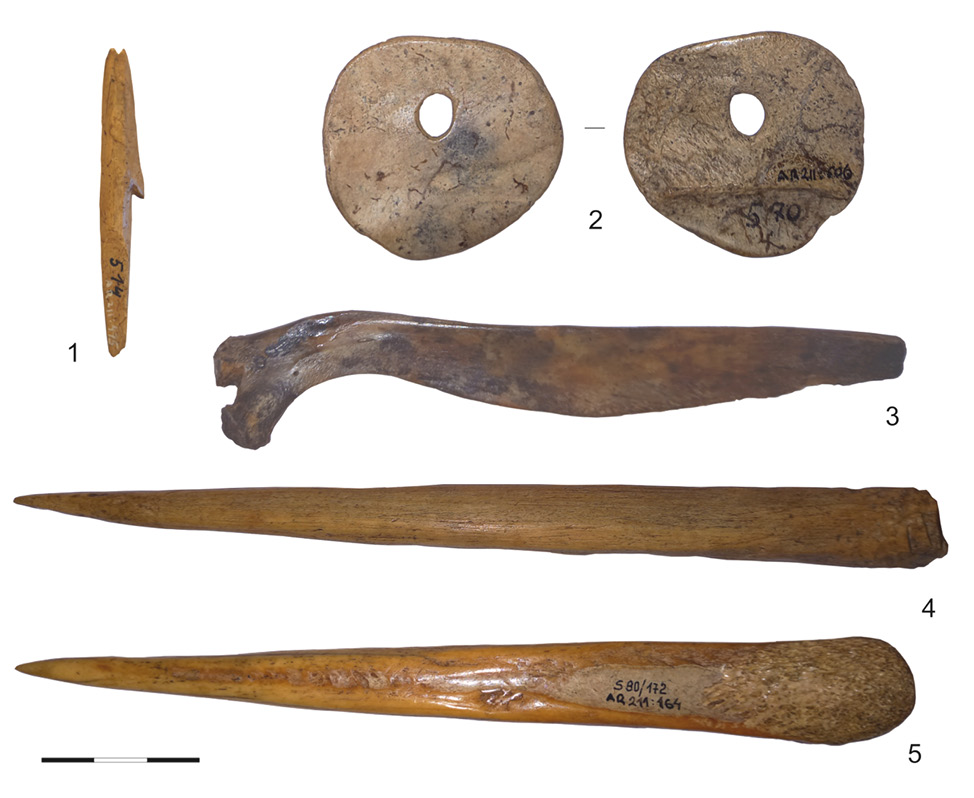
Fig. 9. Bone artefacts from Sokiškiai. 1 – arrowhead made of unidentfied long bone; 2 – disc made of ungulate scapula; 3 – knife made of unidentified rib; 4–5 – daggers made of unidentified long bone and elk metapodia (LNM AR 211: 475, 506, 500, 364, 164). Photos by Heidi Luik.
9 pav. Kauliniai dirbiniai iš Sokiškių. 1 – antgalis iš ilgojo kaulo; 2 – skridinys iš kanopinio gyvūno mentės kaulo; 3 – peilis iš gyvūno šonkaulio; 4–5 durklai iš tiksliau neidentifikuoto ilgojo kaulo ir briedžio metapodijos (LNM AR 211: 475, 506, 500, 364, 164). Heidi Luik nuotraukos
Arrowheads
Only one better preserved arrowhead is found at Sokiškiai, it is carefully worked and has one barb, the tip is broken (Fig. 9:1). From another arrowhead only the tip is preserved and the original shape of it is not known (Grigalavičienė, 1986, fig. 20: 6–7; 1995, fig. 62: 4, 9). Both arrowheads have been made of the diaphysis of an unidentified tubular bone. Some small sharp-tipped bone pieces have been also interpreted as arrowheads (Grigalavičienė, 1986, fig. 20: 1–5; 1995, fig. 63: 15–20, 26, 27); nevertheless, such use cannot be confirmed. Carefully worked bone arrowheads are known also from other Lithuanian sites. Most of them come from Narkūnai where arrowheads with one and two barbs are represented (Grigalavičienė, 1995, fig. 62; Егорейченко, 2006, pl. 19–21; Luik & Maldre, 2007, p. 25, fig. 32). Such arrowheads are much more common in the fortified settlements in Latvia and Estonia (Graudonis, 1989, pl. XVI–XVII, XLIV: 16–19; Vasks, 1994, pl. VIII: 11; Luik, 2006), the above mentioned bone spearheads, on the contrary, were more numerous in Lithuania (Luik & Maldre, 2007, p. 33).
Bone disc
A bone disc with a hole in the middle is made from a scapula of a large ungulate, it has been found at Sokiškiai (Fig. 9: 2; Grigalavičienė, 1986, fig. 19: 1; 1995, fig. 100: 9). The disc is rather irregular and slightly angular. At least one similar disk is known from Petrešiūnai, but it has no hole (Grigalavičienė, 1995, fig. 100: 8). Some comparable artefacts have been found from Loona in Saaremaa, Estonia, one of them has been made of elk mandible (Luik et al., 2011, p. 254, fig. 13: 5–6). Since in Loona there are two sites dating from different time at the same place – a Neolithic settlement site and a Late Bronze Age stone cist grave (Lang, 2007, p. 21, 153, fig. 3, 87; Luik et al., 2011, p. 245, and references there), the dating of these bone discs is not definite. One disc with a hole is known from Asva, but it is larger and very regular, and is made of antler (Luik, 2022a, fig. 5: 5). Bone and antler discs may have been used as decorative details or fasteners of clothes or bags like the large bronze discs and tutuli (Luik, 2022a, p. 112, and references there).
Bone working waste and unfinished objects
Most of the blanks and working waste are fragments of diaphysis of long tubular bones with cutting and working traces (Fig. 10: 1–3, 6–9). Some fragments from Sokiskiai are tubular bones with a spirally broken end, presumably blanks for making chisel-like tools (Fig. 10: 2–3, 9). A similar blank is also known among the finds from Mineikiškės (Podėnas, 2020, jn 41: 48). The narrow strip of long bone diaphysis found from Sokiškiai may be a blank for making a pin (Fig. 10: 9). The presumable unfinished bone pin from Mineikiškės is mentioned already above (Fig. 7: 3). From Sokiškiai also some pieces of flat bones with processing traces are known (Fig. 10: 4–5).
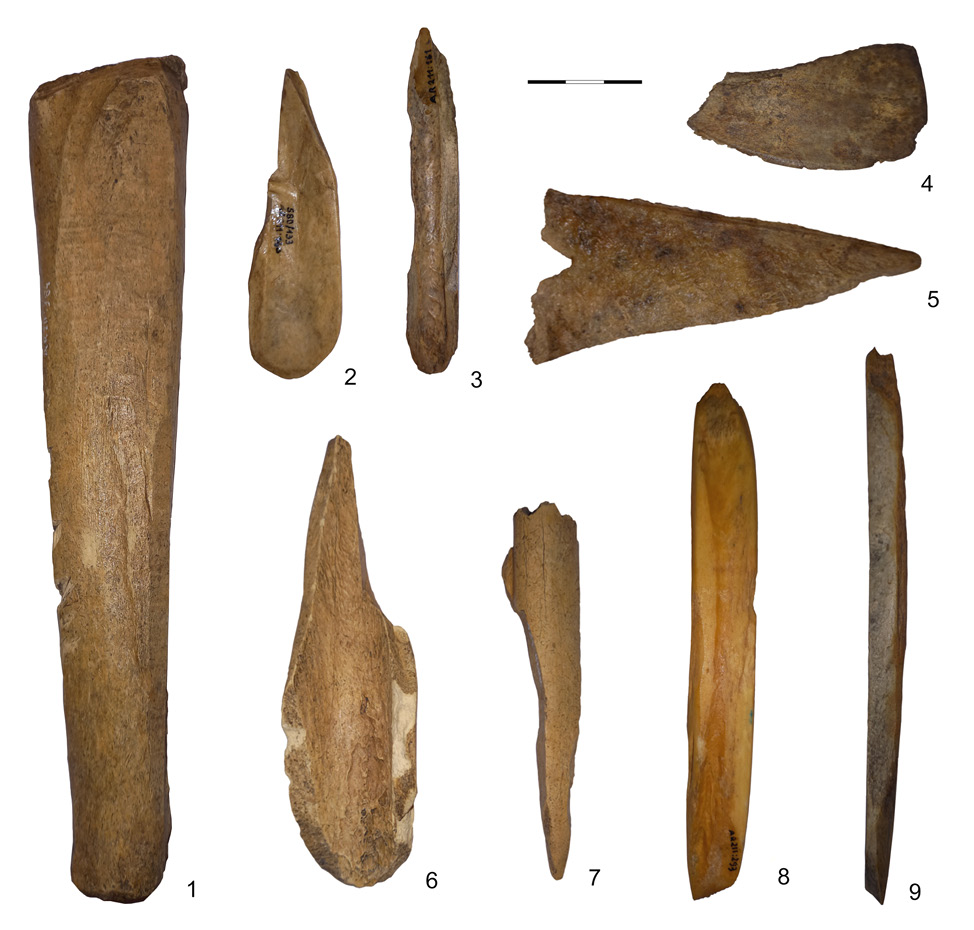
Fig. 10. Bone working waste and unfinished bone items from Sokiškiai. Materials: 1–3, 6–9 – long bones; 4–5 – flat bones (LNM AR 211: 384, 160, 161, 276, 381, 380, 356, 293, 291). Photos by Heidi Luik.
10 pav. Kaulo apdirbimo atliekos ir nebaigti gaminti dirbiniai iš Sokiškių. Žaliava: 1–3, 6–9 – ilgieji kaulai; 4–5 – plokštieji kaulai (LNM AR 211: 384, 160, 161, 276, 381, 380, 356, 293, 291). Heidi Luik nuotraukos
The making and use of bone and antler artefacts
In the case of bone objects at the three discussed sites bone artefacts are much more numerous, bone working waste is relatively few. One reason for that could be that usually a bone with a suitable shape was chosen for making an artefact and therefore there was almost no working waste. Bone waste can also easily get among unprocessed bones, and it is not always possible to identify whether they are kitchen refuse or processing waste.
In the case of antler objects, on the contrary, the working residues are more common, and the finished artefacts are not numerous. Of the sites discussed here, the vast majority of antler objects and working waste have been found from Sokiškiai. From Mineikiškės only seven antler fragments are known, all from a single object, presumably an unfinished handle. The reason for that could be that the excavated area in the other sites and consequently also the number of finds is remarkably smaller. Another reason could be that antler working was practised only at some fortified settlements in this period (Luik, 2022a, 112–113, and references there). In the case of settlements discussed here the analysis of unworked animal bones shows that elk bones are represented differently at these settlements (Table 1). Maybe just particular communities, like Sokiškiai, hunted the large game and so they had access to antler. It is possible that some more carefully worked artefacts were manufactured only at some centres. Such artefact types could have been, for example, polished handles and regularly carved double buttons. At the present stage of investigation only one antler artefact – a double button – is known from Garniai I, antler working waste has not been found there yet. So it is possible that the double button was not made at this site, but brought from elsewhere. At least one handle from Sokiškiai is an unfinished object, indicating that antler handles were manufactured there. Only three antler handles, including the mentioned unfinished handle have been found from Sokiškiai – perhaps handles manufactured there were moved elsewhere. Also some antler tine tips with working traces in Sokiškiai could be blanks for double buttons (Fig. 4: 7–8). Both a blank for making a double button and an unfinished antler handle have also been found from Kereliai fortified settlement among the sites discussed in an earlier article (Luik & Maldre, 2007, fig. 9: 1; 11). Besides Kereliai, antler working waste was found also in Narkūnai, but was almost absent in Nevieriškė (Luik & Maldre 2007).
Antler working waste is mostly found at Ķivutkalns in Latvia and at Asva in Estonia. Of other Estonian sites, at Ridala antler waste is very few, but the finds are mostly fragmentary there and presumably waste pieces were not noticed because of it. Antler processing waste has been found also from Iru, but since the site was also inhabited later, at the Viking Age, it is not known from which period the antler waste originates.
It has been suggested that in socially differenced societies rules may have existed to regulate who could use specific materials and products (e.g., Luik & Maldre, 2007, p. 30, and references there). In the present stage of research, it is not possible to say if some such rules could have existed also in the Late Bronze Age at the eastern Baltic region. In analysing the choice of material one should certainly bear in mind that the scope of the fieldwork carried out at certain sites could influence both the number of found processing waste and the ratio of waste among the total number of finds.
Manufacturing techniques
It is possible to observe manufacturing techniques and tools used for making artefacts primarily in the case of processing waste and unfinished artefacts, but working traces could be observable also on such objects that have not been very carefully finished.
Antler has been cut into smaller pieces (Fig. 11–12) mostly by chopping. The compact part of antler was chopped or hacked around, and the porous middle part was just broken. Such method gives antler pieces a specific shape – the porous middle part forms a protrusion on one piece and a cavity in the porous part of another piece (Fig. 11) (cf. Luik & Maldre, 2007, p. 12, fig. 4).
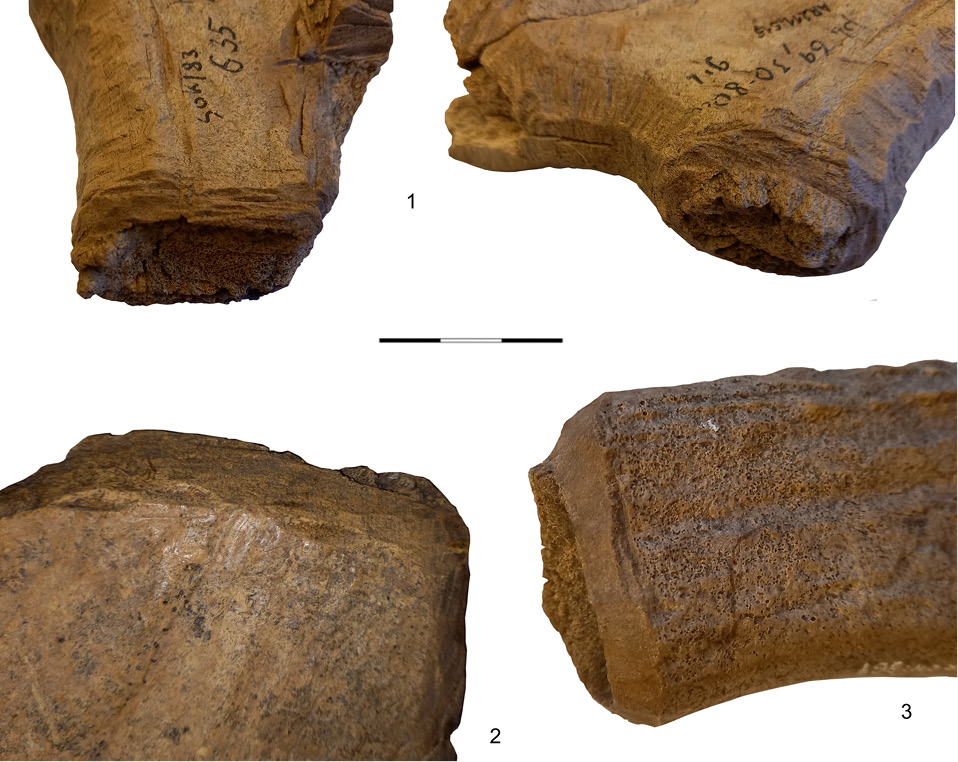
Fig. 11. Working traces on antler objects from Sokiškiai (LNM AR 211: 515 (2), 194, 387). Photos by Heidi Luik.
11 pav. Darbo žymės ant raginių dirbinių iš Sokiškių (LNM AR 211: 515 (2), 194, 387). Heidi Luik nuotraukos
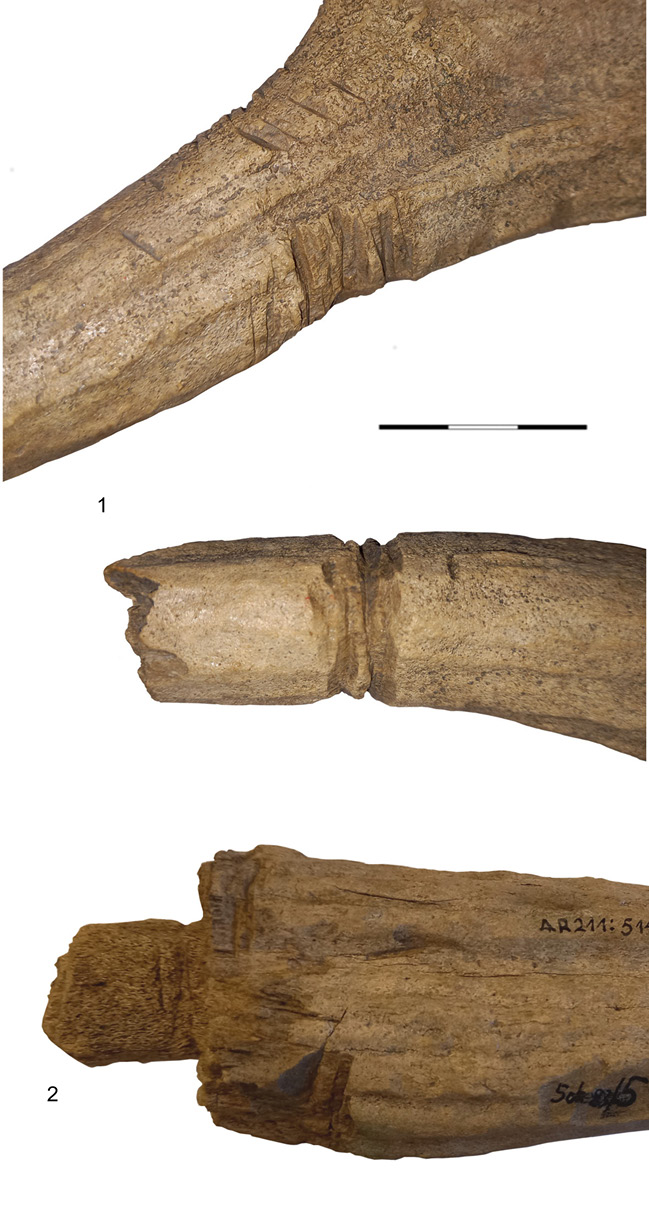
Fig. 12. Working traces on antler objects from Sokiškiai (LNM AR 211: 387 (2), 514). Photos by Heidi Luik.
12 pav. Darbo žymės ant raginių dirbinių iš Sokiškių (LNM AR 211: 387 (2), 514). Heidi Luik nuotraukos
Chopping was also used to cut the bones transversely (Fig. 13: 3), but bones were bisected transversely also by grooving and then breaking (Fig. 13: 2). Longitudinal cutting has also taken place by grooving. Grooving was used both for cutting long bones and flat bones (Fig. 10: 4–5). In the case of long bones, the characteristic spiral fracturing of such bones has been exploited, resulting in a curved end which is particularly suitable for making oval-ended chisels or scrapers (Fig. 10: 2–3, 6). In the case of many objects, especially smaller ones, it is first necessary to get a piece or a strip of a suitable size from bone diaphysis to make them (Fig. 10: 1, 7–9).
To shape the objects, the bones were worked with abrading on the stone to achieve an even, straight and smooth surface. Spearheads, for example, have been treated in this way and the same method has been used for making some types of chisels and awls (Fig. 14), as well as for pin heads (Fig. 15: 3– 4). Longitudinal and diagonal lines as well as transverse cut marks have been left on the surface of the objects from working with flint tool (e.g., Fig. 9: 5, 13: 1, 4–5). Some items, such as pins, often have a very smooth polished surfaces. For example, sand or ash and a piece of leather may have been used for that, but some items are likely to become very smooth and polished over long time use.
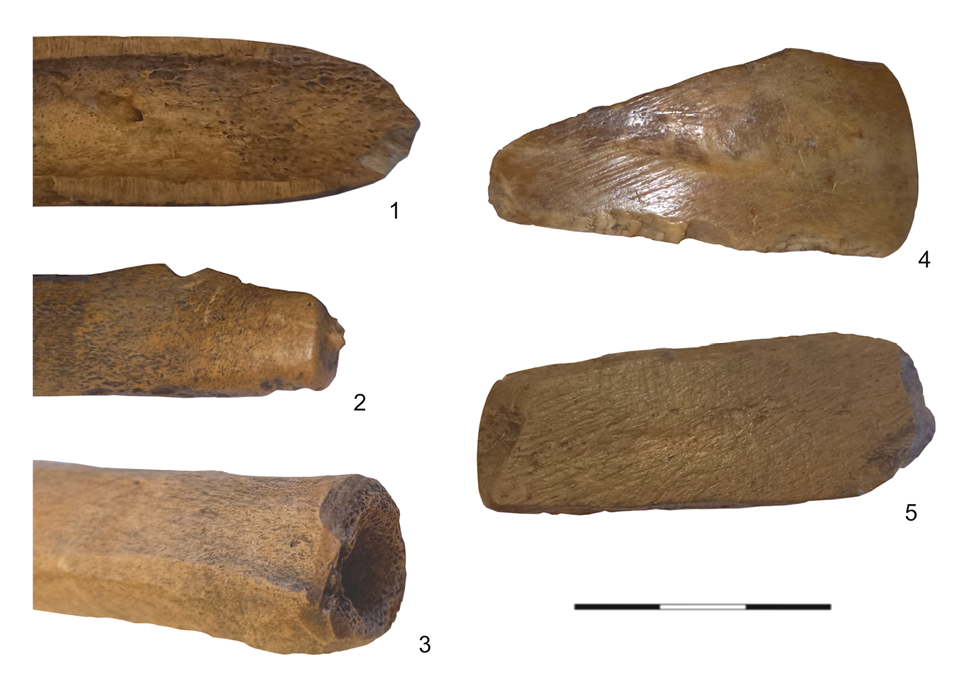
Fig. 13. Working traces on bone objects from Sokiškiai; 1–4 – unidentified long bones; 5 – elk metapodia (LNM RA 211: 274, 371, 384, 282, 489). Photos by Heidi Luik.
13 pav. Darbo žymės ant kaulinių dirbinių iš Sokiškių; 1–4 – nenustatyti ilgieji kaulai; 5 – briedžio metapodija (LNM RA 211: 274, 371, 384, 282, 489). Heidi Luik nuotraukos
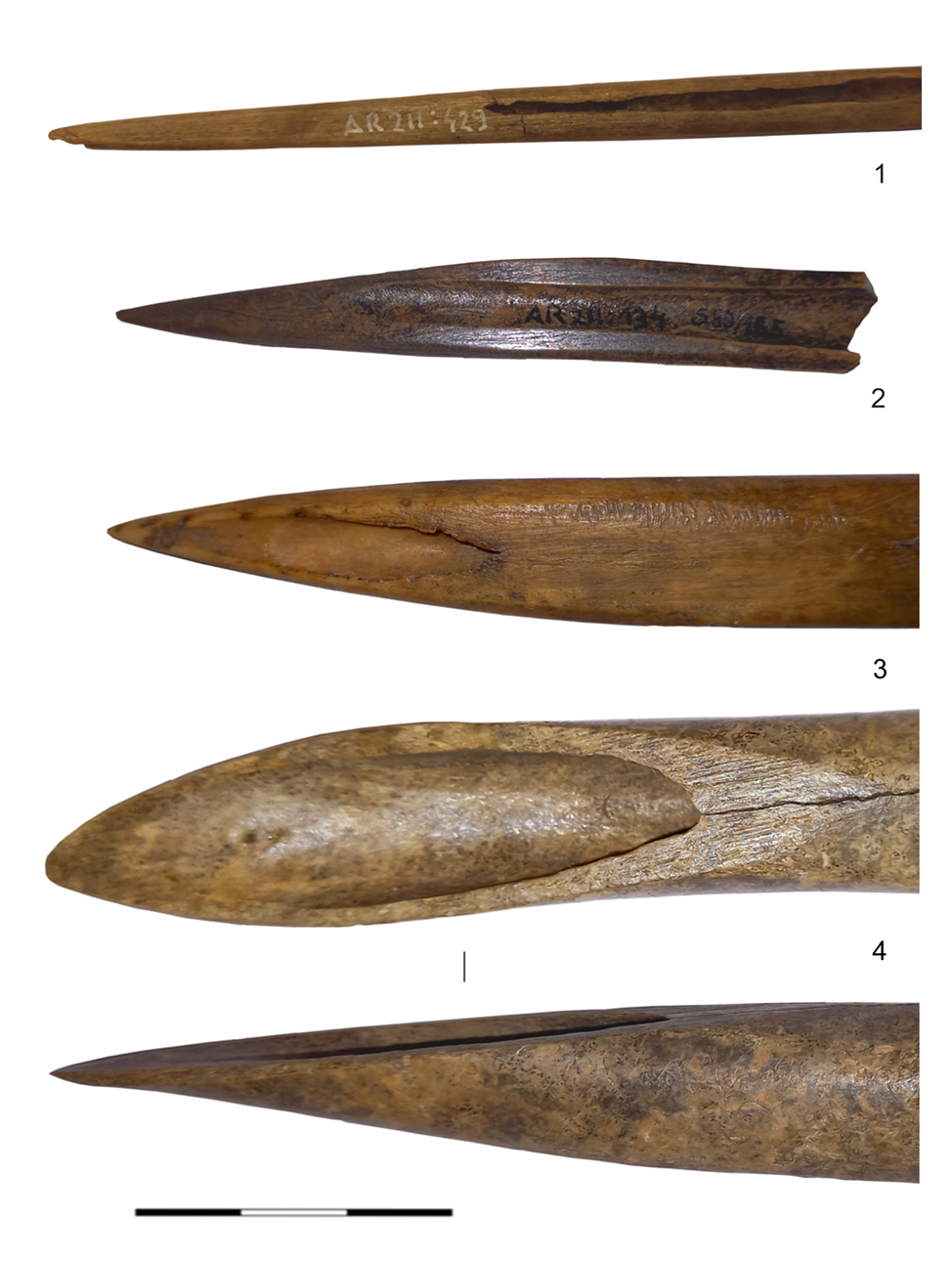
Fig. 14. Working traces on bone objects from Sokiškiai, made of long bones (LNM AR 211: 429, 134, 363, 165). Photos by Heidi Luik.
14 pav. Darbo žymės ant kaulinių dirbinių iš Sokiškių. Dirbiniai pagaminti iš stambių kanopinių gyvūnų kaulų (LNM AR 211: 429, 134, 363, 165). Heidi Luik nuotraukos
Holes have been made in the objects (Figs. 15–16), in which case the use of different methods can be observed. The holes can be cylindrical (Fig. 15: 3–4) or conical (e.g., Fig. 7: 5), both drilled in one direction. Holes with a biconical cross-section were drilled on both sides (Fig. 15: 1; 16: 3). There are also unfinished holes (Fig. 16: 1–2). In the case of one bone pin, it can be seen that the drilling of the hole has been started from both sides (Fig. 15: 2).
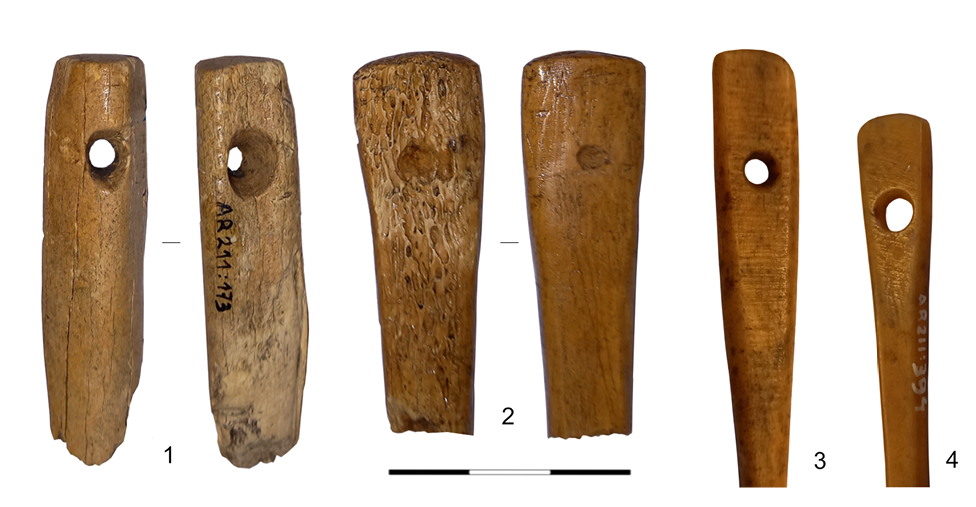
Fig. 15. Bone artefacts with finished and unfinished holes from Sokiškiai, all made of large ungulate long bones (LNM AR 211: 173, 172, 391, 394). Photos by Heidi Luik.
15 pav. Kauliniai dirbiniai su baigtomis ir nebaigtomis daryti skylėmis iš Sokiškių. Dirbiniai pagaminti iš stambių kanopinių gyvūnų kaulų (LNM AR 211: 173, 172, 391, 394). Heidi Luik nuotraukos
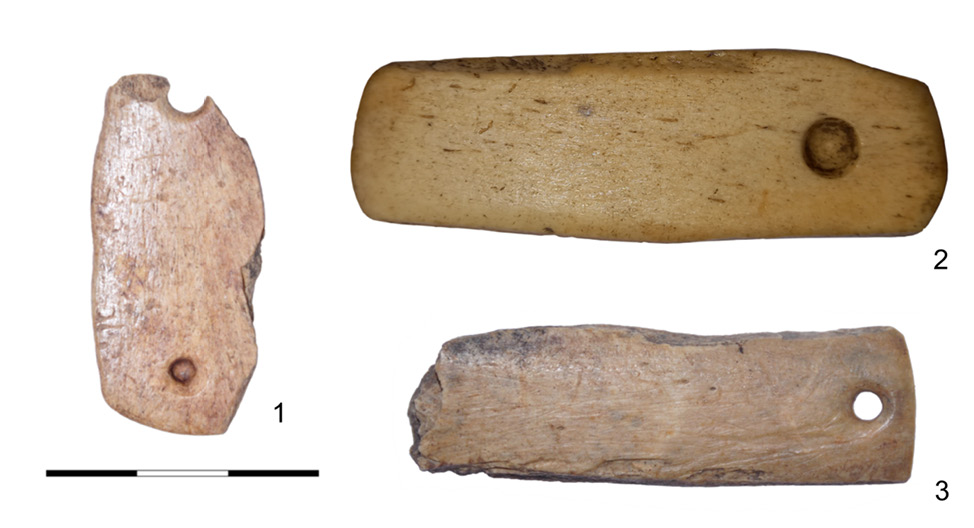
Fig. 16. Bone artefacts with finished and unfinished holes from Mineikiškės (1, 3) and Sokiškiai (2), all made of large ungulate long bones (LNM Mnk 20: 234, LNM AR 211: 169, LNM Mnk 20: 226). Photos by Vytenis Podėnas (1, 3) and Heidi Luik (2).
16 pav. Kauliniai dirbiniai su baigtomis ir nebaigtomis daryti skylėmis iš Mineikiškių (1, 3) ir Sokiškių (2). Dirbiniai pagaminti iš stambių kanopinių gyvūnų kaulų (LNM Mnk 20: 234, LNM AR 211: 169, LNM Mnk 20: 226). Vytenio Podėno (1, 3) ir Heidi Luik (2) nuotraukos
All these working methods have been also used at other Lithuanian Late Bronze Age fortified settlement sites, and also in Latvia and Estonia (Luik & Maldre, 2007; Luik, 2011; 2013).
Only a few decorated objects are among the studied finds. Embossed lines are carved on one of the handles of Sokiškiai (Fig. 3: 3; Grigalavičienė, 1986, fig. 19: 3). Similarly, decorated handles are known also from Byelorus, for example, from Zazony (Егорейченко, 2006, pl. 26: 5), and from Kaali in Estonia (Luik, 2011, fig. 7: 3). Most bone pins from the discussed sites are also plain and undecorated. Only some pins have simple carved protrusions (Grigalavičienė, 1986, fig. 21: 1–5). One pin has incised transverse lines at the head part, which are not regular but rather sloppy and random (Grigalavičienė, 1986, fig. 21: 12). On one pin, the edges of the head are cut serrated (Fig. 7: 9; Grigalavičienė, 1986, fig. 22: 8). The ornament on the few decorated objects consists more often of embossed lines than of engraved patterns.
Were mostly stone or metal tools used for manufacturing bone artefacts? For example, in Hungary mostly flint tools and abrasive stones were used for working osseous materials until the Late Bronze Age (Sofaer et al., 2013, p. 486). In the Late Bronze Age, metal tools were used more often, it has been assumed mostly in the case of artefacts decorated with incised ornaments, which presumably were made by (semi)professional craftsmen (Choyke, 2005, p. 140; Choyke et al., 2004, p. 184; Sofaer, 2010, p. 211–12; Sofaer et al., 2013, p. 482, 487). In southwestern Poland in the Bronze Age metal tools were used in bone working in addition to stone tools, but presumably rather seldom, metal tools became more common only in the Early Iron Age (Baron et al., 2016, pl. 2; Baron & Diakowski, 2018). Objects made of osseous materials were seldom decorated in the sites discussed here, most of artefacts are quite simple and were probably manufactured mostly with stone tools (cf. Luik & Maldre, 2007; Luik, 2013; 2022a, 114–115).
Use of bone and antler items
A significantly large part of found osseous artefacts are chisels and scrapers with different shapes and widths (Fig. 5), and awls and points with different sizes (Fig. 6), both made of bones of various animal species. Some types of chisels and awls have a quite standardised shape and certain bones of certain animal species have been used for making these tools; presumably these tools were used for some specific tasks. On the other hand, more occasional bone tools are also quite numerous. In this case, the tool made from a currently available bone was probably used for the activity required at the moment. As mentioned above, chisels and scrapers were used for working several materials. One possible use could be cleaning and working of hide and leather. Awls and points were used for making holes for sewing into leather, but also birch bark or other types of bark. Several points could also have been used for twining and weaving as already mentioned. Considering the abundance of chisels-scrapers and awls-points, a large part of the bone artefacts of the discussed Lithuanian sites may have been related to leather or hide processing. Livestock farming played an important role in the fortified settlements, and one of its products was animal hides. It is possible that treated animal skins, as well as furs and leather goods, were barter items for which bronze, an important raw material, could be exchanged (e.g., Earle, 2002, p. 312; Luik & Maldre, 2007, p. 32).
The third large artefact type is pins (Fig. 7), used for fastening garments. Although bone pins were used also in the Neolithic sites, the large number of pins in the Late Bronze Age fortified settlements is remarkable. This is probably related to changes in clothing – the clothes used at that time needed pins for fastening. While in Central and Northern Europe various bronze pins were used to fasten clothes, on the eastern shore of the Baltic Sea bronze pins were rather rare and the main means of fastening clothes was bone, less often also antler pins. The large number of bone pins suggests that the clothing style here was presumably similar to the clothing of Central and Northern Europe at the time, meaning that the clothes were attached with pins. In addition to the function of attaching clothing, pins were also used as ornaments. Still, among the pins found in the discussed settlements, simple pins, having a rather practical function predominated. As graves from that time are almost not known in north-eastern Lithuania, it is not clear how the needles were worn and who used them. In Latvia, in Ķivutkalns cemetery bone pins have been found in about one fifth of the burials studied. In most cases, there was one pin in the grave, which was located on the shoulder or chest, the pins were found both in the graves of men, women, and children (Денисова et al., 1985, p. 40–41, fig. 17, 23, 27, 29, pl. XIX: 3, XXII: 1–3, table 6). In Estonia, bone pins have been found mainly in stone cist graves, the distribution area of which generally does not overlap with that of fortified settlements. The bone pins found in stone cist graves seem more likely to be associated with the burials of men, the spade-headed bone pins typical to these graves are thought to have been used not to fasten clothing but to style hair (Lang & Luik, 2022, fig. 5). Two or more bronze pins were often placed into the graves in Central Europe and Scandinavia (Probst, 1999, p. 56, 171; Sørensen, 1997, fig. 3–4; Harding, 2000, p. 374, fig. 11.4; Bergerbrant, 2007, p. 89, fig. 41, 47, 65, 69–70, 84, 89 ff.); a different use of pins as fasteners for clothing or leather bags can be observed in different regions (Bergerbrant, 2007, p. 70 ff.). So, there are different possibilities and since so far it has not been possible to investigate burial sites of the time, no conclusions can be drawn about the use of these pins in the region discussed here.
The number of other artefact types is rather small. A bit more numerous are bone spearheads, with more than a dozen specimens, all other types are represented with less than ten examples. Spearheads are produced from standardised materials – the majority of determinable items are made of goat/sheep tibiae. It is possible that these spearheads were used as weapons for warfare, although they could have been used for hunting also (Luik & Maldre, 2007, p. 31–32). Carefully worked bone arrowheads, which could have been warfare weapons (Luik, 2006) are represented only with a couple of finds – an arrowhead with one barb (Fig. 9: 1) and a fragment of an arrowhead’s tip. Small pointed bone fragments considered to be arrowheads, may have been arrowheads used for hunting smaller animals. A couple of large points from the diaphysis of the large long bones have also been interpreted as weapons – daggers.
A few tools, like antler handles and rib knives, have also been found. It is not known if a metal or a stone blade was fixed into these handles (Luik, 2011, p. 42–43). Handles discussed here are all fragmentary (Fig. 3: 3–4), the cavity for the blade is not preserved and therefore it is not possible to make even speculative decisions about the material of the blade fitting the shape of the cavity. Rib knives were presumably used for hide or leather working, perhaps for removing hair from hide (Luik, 2022b). Some single finds could have belonged to the clothing, like an antler double button (Fig. 3: 2; Luik & Ots, 2007), a quadrangular rib plate with holes, and a bone disc (Fig. 9: 2), which could have been used as a decorative item or fastening details on the garment or bag (e.g., Becker, 2005; Luik, 2022a). Tooth pendants were probably also sewn or hanged to clothing (Fig. 2).
Regional differences
Comparing the bone artefacts of the sites discussed in the present article with the Late Bronze Age bone artefacts of the other eastern Baltic regions, a greater similarity can be observed among the finds of fortified settlements in north-eastern Lithuania, eastern Latvia, and north-western Byelorus.
The greater similarity of bone artefacts in eastern Latvia and north-eastern Lithuania was already noticed when analysing the bone objects of Narkūnai, Nevieriškė and Kereliai and comparing them with the finds of the rest of the Baltic countries (Luik & Maldre, 2007). Such differences are, for example, the scarcity of antler objects in the settlements of north-eastern Lithuania, and their greater number in the lower reaches of the Daugava River and in Estonia. Among such antler artefacts, ard points/hoes, harpoon heads, antler points with spiral use wear and double buttons could be mentioned (Luik, 2013), which are absent or represented with only few finds in north-eastern Lithuania, eastern Latvia, and north-western Byelorus. In this region bone spearheads were used which are very rare in the lower reaches of the Daugava River and in Estonia where carefully worked bone arrowheads were much more common (Graudonis, 1989; Luik, 2006; Luik & Maldre, 2007). However, bronze spearheads and also casting moulds for such speraheads have been found from the Daugava basin and western Latvia, and Estonia (Podėnas et al., 2022, p. 234, and references there). The differences could be observed also in the abundance or scarcity of bone scrapers, in the methods of making awls from goat/sheep metapodium bones, and in the spread of certain pin types (Luik & Maldre, 2007; Luik, 2009; 2013; Lang & Luik, 2022). As can be seen from the above analysis, the presence of these variations is observable also in the sites discussed in this article. The reason may be in the differences of occupations in some cases (e.g., harpoons were used for hunting marine mammals, ards/hoes for field cultivation, bone scrapers for hide and leather working) while in other cases it may have depended on the cultural choices and habits of the particular society, in which way and from which material an artefact used for a certain purpose was to be made.
There are differences also in animal breeding, where different species have been dominant in different regions of the Baltic states based on the domestic animal bones found in fortified settlements – pigs in north-eastern Lithuania, cattle in the settlements of the lower reaches of the Daugava, and goats and sheep in the settlements of coastal Estonia (e.g., Graudonis, 1989, table 8–9; Vasks, 1994, p. 118; Grigalavičienė, 1995, p. 99, 268; Lang, 2007, p. 110–111; Luik & Maldre, 2007, fig. 2; Sperling, 2014, p. 341 ff.). The cultural area covering north-western Byelorus, north-eastern Lithuania, and south-eastern Latvia has also been observed in the case of earthenware common there – striated pottery, which is characteristic of fortified settlements in this region (Егорейченко, 2006; Lang, 2018, p. 141 ff., fig. 4.14).
Conclusions
Among the approximately 500 osseous objects analysed in this study, bone objects predominate. The antler is less used and there are only few items made of teeth. Of sites discussed here, there are more antler objects and waste in Sokiškiai, but it is not clear whether this indicates that antler processing could have been concentrated in particular settlements or that it is just random and resulting from the fact that other sites have been studied to a much lesser extent. Of the animal species, the bones of pigs and goats/sheep could be determined most often. The most numerous identified bones are metapodia – the metatarsals and the metacarpals. Other long tubular tubes, but less often also ribs and other flat bones, have been used. In the case of many objects, it was only possible to identify that they were made from the bones of large ungulates. The most numerous among them probably are bovine bones, but horse and elk bones could also have been used.
Three major groups predominate among the artefact types: chisels-scrapers, awls-points, and pins. The first two are tools that could be used for a variety of works, among which leather and hide processing could have been important, the products of which might have been exchanged for an important raw material, bronze. The third most common type – pins – is evidence of clothes that required pins to fasten them. Bone objects of the discussed sites indicate a greater similarity in the find material of the fortified settlements of north-eastern Lithuania, eastern Latvia, and north-western Byelorus.
References
Baron J. & Diakowski M. 2018. Tools make tools: changes in bone and antler manufacture at Late Bronze and Early Iron Age Polish sites. Antiquity, 92, e5. DOI:10.15184/aqy.2018.98
Baron J., Diakowski M. & Badura B. 2022. Manufacture and use: bone and tooth objects from the Late Bronze Age ’shaman’s grave’ at Przeczyce, Poland. Antiquity, 96/387, p. 1–8. https://doi.org/10.15184/aqy.2022.39
Baron J., Diakowski M. & Stolarczyk T. 2016. Bone and antler artefacts from an 8–5th century BC settlement at Grzybiany, south-western Poland. S. Vitezović (ed.) Close to the bone. Current studies in bone technologies. Belgrade: Institute of Archaeology, p. 28–47.
Bergerbrant S. 2007. Bronze Age Identities: Costume, Conflict and Contact in Northern Europe 1600–1300 BC. Stockholm Studies in Archaeology, 43. Lindome: Bricoleur Press.
Bērziņš V., Brinker U., Klein C., Lübke H., Meadows J., Rudzīte M., Schmölcke U., Stümpel H. & Zagorska I. 2014. New research at Riņņukalns, a Neolithic freshwater shell midden in northern Latvia. Antiquity, 88/341, p. 715–732. doi:10.1017/S0003598X0005064X
Bliujienė A., Skipitytė R., Garbaras A., Miliauskienė Ž., Šapolaitė J., Ežerinskis Ž., Čeponkus J., Masiulienė I., Simčenka E., Minkevičius K. & Piličiauskienė G. 2020. The first data on the human diet in Late Roman and Early Migration period western Lithuania: Evidence from stable isotope, archaebotanical and zooarchaeological analyses. Journal of Archaeological Science: Reports, 33, 102545. https://doi.org/10.1016/j.jasrep.2020.102545.
Choyke A. M. 2005. Bronze Age bone and antler working at the Jászdózsa-Kápolnahalom tell. H. Luik, A. M. Choyke, C. E. Batey & L. Lõugas (eds.) From Hooves to Horns, from Mollusc to Mammoth. Manufacture and Use of Bone Artefacts from Prehistoric Times to the Present. Proceedings of the 4th Meeting of the ICAZ Worked Bone Research Group at Tallinn, 26th–31st of August 2003. Muinasaja teadus, 15. Tallinn: Institute of History, p. 129–156.
Choyke A. M., Vretemark M. & Sten S. 2004. Levels of social identity expressed in the refuse and worked bone from the Middle Bronze Age Százhalombatta-Földvár, Vatya culture, Hungary. S. Jones O’Day, W. van Neer & A. Ervynck (eds.) Behavior Behind Bones. The Zooarchaeology of Ritual, Religion, Status and Identity. Oxford: Oxbow Books, p. 177–189.
Christidou R. & Legrand A. 2005. Hide working and bone tools: Experimentation design and applications. H. Luik, A. M. Choyke, C. E. Batey & L. Lõugas (eds.) From Hooves to Horns, from Mollusc to Mammoth. Manufacture and Use of Bone Artefacts from Prehistoric Times to the Present. Proceedings of the 4th Meeting of the ICAZ Worked Bone Research Group at Tallinn, 26th–31st of August 2003. Muinasaja teadus, 15. Tallinn: Institute of History, p. 385–396.
Čivilytė A., Podėnas V. & Vengalis R. 2017. Garnių piliakalnis I. G. Zabiela (ed.) Archeologiniai tyrinėjimai Lietuvoje 2016 metais. Vilnius: Lietuvos archeologijos draugija, p. 69–73.
Earle T. 2002. Bronze Age Economics. The Beginning of Political Economies. Oxford: Westview Press. https://doi.org/10.4324/9780429501999
Graudonis J. 1989. Nocietinātās apmetnes Daugavas lejtecē. Riga: Zinātne.
Grigalavičienė E. 1986. Sokiškių piliakalnis. Lietuvos archeologija, 5, p. 89–138.
Grigalavičienė E. 1995. Žalvario ir ankstyvasis geležies amžius Lietuvoje. Vilnius: Mokslo ir enciklopedijų leidykla.
Harding A. F. 2000. European Societies in the Bronze Age. Cambridge: Cambridge University Press. https://doi.org/10.1017/CBO9780511605901
Harding A., Ostoja-Zagórski J., Palmer C. & Rackham J. 2004. Sobiejuchy: A Fortified Site of the Early Iron Age in Poland. Polskie Badania Archeologiczne, 35. Warsaw: Institute of Archaeology and Ethnology, Polish Academy of Sciences.
Jonuks T. & Rannamäe E. 2015. Loomad ehteks – hammas- ja luuripatsid Eestis kiviajast keskajani. Tutulus. Eesti arheoloogia aastakiri, p. 18–20.
Lang V. 1996. Muistne Rävala. Muistised, kronoloogia ja maaviljelusliku asustuse kujunemine Loode-Eestis, eriti Pirita jõe alamjooksu piirkonnas, I–II. Tallinn: Eesti Teaduste Akadeemia Ajaloo Instituut.
Lang V. 2007. The Bronze and Early Iron Ages in Estonia. Tartu: Tartu University Press. http://library.oapen.org/handle/20.500.12657/34490
Lang V. 2018. Läänemeresoome tulemised. Muinasaja teadus, 28. Tartu: University of Tartu Press.
Lang V. & Luik H. 2022 (in print). Pronksiaegsed luust ehtenõelad Läänemere idaranniku maades. H. Luik, Ü. Tamla & V. Lang (eds.) Ilusad asjad, põnevad lood. Muinasaja teadus, 29. Tartu: University of Tartu Press, p. 227–263.
Luik H. 2009. Skill, knowledge and memory. How to make a bone awl properly? A. Šnē and A. Vasks (eds.) Memory, Society and Material Culture. Papers from the third theoretical seminar of the Baltic Archaeologists (BASE) held at the University of Latvia, October 5–6, 2007. Riga, Helsinki, Tartu, Vilnius: University of Latvia, University of Helsinki, University of Tartu, University of Vilnius, p. 45–58.
Luik H. 2011. Material, technology and meaning: antler artefacts and antler working on the eastern shore of the Baltic Sea in the Late Bronze Age. Estonian Journal of Archaeology, 15/1, p. 32–55. doi: 10.3176/arch.2011.1.03
Luik H. 2013. Luu- ja sarvetöötlemisest Läänemere idakaldal nooremal pronksiajal: sarnasused ja erinevused Eesti, Läti ja Leedu leiuaineses. K. Johanson and M. Tõrv (eds.) Man, his Time, Artefacts, and Places. Collection of articles dedicated to Richard Indreko. Muinasaja teadus, 19. Tartu: University of Tartu, p. 387–426.
Luik H. 2022a. Craftspeople in the Late Bronze Age. Bone and antler working at fortified settlements in the eastern Baltic region. D. Hofmann, F. Nikulka and R. Schumann (eds.) The Baltic in the Bronze Age. Regional Patterns, Interactions and Boundaries. Leiden: Sidestone Press, p. 103–122.
Luik H. 2022b (in print). Lameluude kasutamisest esinevates kultuurikontekstides. H. Luik, Ü. Tamla and V. Lang (eds.) Ilusad asjad, põnevad lood. Muinasaja teadus, 29. Tartu: University of Tartu Press, p. 59–100.
Luik H. & Lang V. 2013. Late Bronze Age elk antler tools in the eastern Baltic region. F. Lang (ed.) The Sound of Bones. Proceedings of the 8th meeting of the ICAZ worked bone research group in Salzburg 2011. Salzburg: University of Salzburg, p. 173–184.
Luik H. & Maldre L. 2007. Bronze Age bone artefacts from Narkūnai, Nevieriškė and Kereliai fortified settlements. Raw materials and manufacturing technology. Archaeologia Lituana, 8, p. 5–39.
Luik H. & Ots M. 2007. Bronze Age double buttons in Estonia. Estonian Journal of Archaeology, 11/2, p. 122–140.
Luik H., Ots M. & Maldre L. 2011. From the Neolithic to the Bronze Age: continuity and changes of bone artefacts in Saaremaa, Estonia. J. Baron and B. Kufel-Diakowska (eds.) Written in Bones. Studies on Technological and Social Contexts of Past Faunal Skeletal Remains. Wrocław: Uniwersytet Wrocławski, Instytut Archeologii, p. 243–261.
Maigrot Y. 2005. Ivory, bone and antler tools production systems at Chalain 4 (Jura, France): late Neolithic site, 3rd millennium. H. Luik, A. M. Choyke, C. E. Batey & L. Lõugas (eds.) From Hooves to Horns, from Mollusc to Mammoth. Manufacture and Use of Bone Artefacts from Prehistoric Times to the Present. Proceedings of the 4th Meeting of the ICAZ Worked Bone Research Group at Tallinn, 26th–31st of August 2003. Muinasaja teadus, 15. Tallinn: Institute of History, p. 113–126.
Mannermaa K. & Rainio R. 2014. Tracing the rattle sound of animal tooth pendants from the Middle Neolithic graves of Ajvide, Gotland, Sweden. World Archaeology, 46, p. 332–348. https://doi.org/10.1080/00438243.2014.909105
Minkevičius K. 2021. Mineikiškių piliakalnio (5705) teritorijos, Mineikiškių k., Zarasų sen., Zarasų r. sav., 2020 m. detaliųjų archeologinių tyrimų ataskaita. Lietuvos istorijos instituto rankraštynas, f. 1, b. 10282.
Minkevičius K., Podėnas V., Urbonaitė-Ubė M., Ubis E. & Kisielienė D. 2020. New evidence on the southeast Baltic Late Bronze Age agrarian intensification and the earliest AMS dates of Lens culinaris and Vicia faba. Vegetation History and Archaeobotany, 29/3, p. 327–338. Doi: 10.1007/s00334-019-00745-2
Piličiauskas G., Matiukas A., Peseckas K., Mažeika J., Osipowicz G., Piličiauskienė G., Rannamäe, Pranckėnaitė E., Vengalis R. & Pilkauskas M. 2020. Fishing history of the East Baltic during the Holocene according to underwater multiperiod riverine site Kaltanėnai, northeastern Lithuania. Archaeological and Anthropological Science, 12, 279. https://doi.org/10.1007/s12520-020-01233-9
Podėnas V. 2018. Mineikiškių piliakalnis. G. Zabiela (ed.) Archeologiniai tyrinėjimai Lietuvoje 2017 metais. Vilnius: Lietuvos archeologijos draugija, p. 89–91.
Podėnas V. 2020a. Emergence of hilltop settlements in the Southeastern Baltic: New AMS 14C dates from Lithuania and revised chronology. Radiocarbon, 62/2, p. 1–17. Doi: 10.1017/RDC.2019.152
Podėnas V. 2020b. Mineikiškių piliakalnio (5705) teritorijos, Mineikiškių k., Zarasų sen., Zarasų r. sav., 2017 m. detaliųjų archeologinių tyrimų ataskaita. Lietuvos istorijos instituto rankraštynas, neinventorinta.
Podėnas V., Minkevičius K., Micelicaitė V. & Čivilytė A. 2022. Fortify to develop contacts? A review of Late Bronze Age defensive systems in the East Baltic and new data from Mineikiškės fortified settlement. V. Vaitkevičius and A. Bliujienė (eds.) Discovering the Past. Preserving for the Future. Essays on the Occasion of Gintautas Zabiela’s 60th Birthday. Klaipėda: Klaipėdos universiteto leidykla, p. 218–240.
Pranckėnaitė E. 2012. Ežerų gyvenvietės pietryčių Baltijos regione ankstyvuoju metalų laikotarpiu. PhD Thesis. Klaipėda University.
Probst E. 1999. Deutschland in der Bronzezeit. Bauern, Bronzegiesser und Burgherren zwischen Nordsee und Alpen. München: Orbis.
Russell N. 2001. Neolithic relations of production: insights from the bone tool industry. A. M. Choyke and L. Bartosiewicz (eds.) Crafting Bone: Skeletal Technologies through Time and Space. Proceedings of the 2nd Meeting of the (ICAZ) Worked Bone Research Group, Budapest, 31 August – 5 September 1999. British Archaeological Reports, International Series, 937. Oxford, p. 271–280.
Sofaer J., Bender Jørgensen L. & Choyke A. 2013. Craft production: ceramics, textiles, and bone. H. Fokkens and A. Harding (eds.) The Oxford Handbook of the European Bronze Age. Oxford: Oxford University Press, p. 469–491.
Sørensen M. L. S. 1997. Reading dress: the construction of social categories and identities in Bronze Age Europe. Journal of European Archaeology, 5/1, p. 93–114. https://doi.org/10.1179/096576697800703656
Sperling U. 2014. Aspekte des Wandels in der Bronzezeit im Ostbaltikum. Die Siedlungen der Asva-Gruppe in Estland. Estonian Journal of Archaeology, Supplementary Volume, 18/2S. Tallinn: Estonian Academy Publishers. DOI: 10.3176/arch.2014.2S.01
Sperling U., Lang V., Paavel K. & Kimber A. 2015. Neue Ausgrabungen in der Bronzezeitsiedlung von Asva – vorläufiger Untersuchungsstand und weitere Ergebnisse. Archaeological Fieldwork in Estonia in 2014, p. 51–64.
Sperling U., Karlsen H.-J., Lang V., Lõugas L. & Lau R. 2021. Ausgrabungen in Asva im Jahr 2020 – Auf den Spuren des Bronzegieẞerplatzes. Archaeological Fieldwork in Estonia in 2020, p. 53–64.
Šmigelskas R. 2018. Devynios absoliučios datos iš Gedimino kalno tyrimų. Archaeologia Lituana, 19, p. 100–119. Doi: 10.15388/ArchLit.2018.19.6
Vasks A. 1994. Brikuļu nocietinātā apmetne. Lubāna zemiene vēlajā bronzas un dzelzs laikmetā (1000. g. pr. Kr. – 1000. g. pēc Kr.). Rīga: University of Latvia. https://dspace.lu.lv/dspace/handle/7/369
Вассар А. 1955. Укрепленное поселение Асва на острове Сааремаа. H. Moora and L. Jaanits (eds.) Muistsed asulad ja linnused. Arheoloogiline kogumik, 1. Tallinn: Eesti Riiklik Kirjastus, p. 113–137.
Данилченко В. 1983. Результаты исследований остеологического материала городища Сокишкис (Игналинский р-н) 1980–1984 гг. Lietuvos istorijos instituto rankraštynas, f. 1, b. 1182, p. 1–2.
Денисова Р. Я., Граудонис Я. Я. & Гравере Р. У. 1985. Кивуткалнский могильник эпохи бронзы. Рига: Зинатне.
Егорейченко А. 2006. Куьтуры штрихованной керамики. Минск: Белорусский Государственный Университет.
Граудонис Я. Латвия в эпоху поздней бронзы и раннего железа. Начало разложения первобытно-общинного строя. Рига: Зинатне.
Gyvūnų kaulai, kauliniai dirbiniai ir kaulo apdirbimas įtvirtintose Sokiškių, Mineikiškių ir Garnių I gyvenvietėse šiaurės rytų Lietuvoje vėlyvajame bronzos amžiuje
Heidi Luik, Giedrė Piličiauskienė, Vytenis Podėnas, Viktorija Micelicaitė, Karolis Minkevičius ir Agnė Čivilytė
Santrauka
Vėlyvojo bronzos amžiaus įtvirtintų gyvenviečių daugiausia aptinkama dabartinės Lietuvos šiaurės rytinėje dalyje. Archeologinių tyrimų metu jose randama nemažai kaulo ir rago dirbinių. Prieš 15 metų išsamiau jau buvo tyrinėti ir publikuoti keleto žymiausių šiaurės rytų Lietuvos piliakalnių – Narkūnų, Nevieriškės ir Kerelių – kauliniai dirbiniai (1 pav.: 4–6; Luik, Maldre, 2007). Šiame straipsnyje yra aptariami keleto kitų šio regiono įtvirtintų gyvenviečių – Sokiškių, Mineikiškių ir Garnių I – kauliniai dirbiniai bei jų gamybos atliekos (1 pav.: 1–3). Minėtų gyvenviečių archeologinio ištyrimo lygis labai skiriasi ir tai yra viena iš priežasčių, kodėl toks skirtingas kiekvienoje jų rastų ir šioje publikacijoje pristatomų kaulo bei rago dirbinių skaičius. Iš viso Lietuvos nacionalinio muziejaus rinkiniuose yra saugoma daugiau kaip 600 Sokiškių, Mineikiškių ir Garnių I įtvirtintose gyvenvietėse rastų kaulinių dirbinių ir jų gamybos atliekų. Tiesa, kaip paaiškėjo atlikus tyrimus, tarp jų pasitaikė ir kaulų bei ragų fragmentų be jokių apdirbimo žymių. Šie radiniai mūsų darbe neanalizuoti.
Zooarcheologinėje aptariamų gyvenviečių medžiagoje dominavo žinduolių liekanos, o apie 90 % kaulų fragmentų priklausė naminiams gyvuliams. Iš jų daugiausia rasta kiaulių kaulų fragmentų, antroje vietoje buvo avys / ožkos (Mineikiškėse ir Garniuose I) arba galvijai (Sokiškiuose). Dauguma dirbinių buvo pagaminti iš kaulo, vos keletu atvejų buvo apdirbti ragai ir dantys (1 lentelė; 2–3 pav.). Daugiausia, apie 400 kaulo ir rago dirbinių bei jų gamybos atliekų buvo rasta ir ištirta Sokiškių įtvirtintoje gyvenvietėje. O Mineikiškėse ir Garniuose I buvo rasta vos kiek daugiau negu 50 kaulo ir rago dirbinių. Dirbiniai daugiausia buvo gaminami iš smulkių naminių gyvulių – kiaulių ir avių / ožkų ilgųjų kaulų, nors nemaža dalis buvo padaryti ir iš stambių kanopinių gyvūnų ilgųjų kaulų. Greičiausiai šiuo tikslu buvo naudojami galvijų kaulai, nes, kaip parodė kitų rytų Baltijos regiono įtvirtintų gyvenviečių tyrimai, kauliniai dirbiniai gaminti iš maistui dažniausiai naudotų gyvulių rūšių kaulų.
Skirtingų tipų ir paskirties dirbinių kiekis gyvenvietėse skyrėsi (2 lentelė). Daugiausia aptikta kaltelių ir gremžtukų (5 pav.), taip pat ylos tipo dirbinių (6 pav.). Treti pagal gausą – kauliniai smeigtukai (7 pav.), o kitų tipų dirbinių gerokai mažiau (8–9 pav.). Įdomu, kad nors kaulinių dirbinių aptikta nemažai, jų gamybos atliekų rasta labai nedaug (10 pav.). Šio reiškinio priežastys gali būti kelios. Dirbiniams gaminti būdavo parenkami labiausiai būsimo įrankio formą atitinkantys kaulai, kurių apdirbimas beveik nepalikdavo jokių specifinių atliekų. Dėl šios priežasties dirbinių gamybos atliekos dažniausiai yra priskiriamos neapdirbtiems kaulams. O štai rago apdirbimo atliekų rasta palyginti nemažai (4 pav.), nors pačių dirbinių nedaug.
Rago ir kaulo apdirbimo būdus galima įvardyti kaip tradicinius. Pasirinkti kaulai bei ragai dalinti į smulkesnes dalis – kapojami (11–12, 13: 3 pav.), pjaustomi ir laužomi (10: 4–5, 13: 2 pav.). Be to, buvo naudojami natūraliai spirališkai lūžę ilgieji kaulai. Tokio lūžio suformuotas išgaubtas kaulo galas buvo tinkamas ovaliems kaltams ir gremžtukams gaminti (10: 2–3, 6 pav.). Dirbiniai buvo formuojami gludinant juos akmenimis (14; 15: 3–4 pav.). Be to, ant kai kurių dirbinių paviršiaus yra matomos išilginės, įstrižos ar skersinės įraižos nuo titnaginių įrankių (9: 5, 13: 1, 4–5 pav.). Skylės dirbiniuose formuotos skirtingais būdais (15–16 pav.). Vos keletas dirbinių buvo papuošti. Dauguma dirbinių yra labai paprasti ir greičiausiai yra pagaminti naudojant akmeninius įrankius. Tokiais pat būdais kauliniai dirbiniai buvo gaminami ir kitose įtvirtintose Lietuvos, taip pat Latvijos bei Estijos gyvenvietėse.
Itin didelę dirbinių grupę sudaro kailiams ir odoms apdirbti naudoti dirbiniai – kalteliai, gremžtukai, ylos ir kiti ylos tipo dirbiniai. Gyvulininkystė buvo svarbi įtvirtintose gyvenvietėse gyvenusių bendruomenių ūkio šaka, o vienas iš jos produktų buvo gyvulių odos. Gali būti, kad gyvulių odos, kailiai ir odos gaminiai buvo mainų objektas ir keisti į svarbią žaliavą – bronzą.
Dar viena didelė dirbinių grupė yra smeigtukai, naudoti drabužiams susegti. Nors kaulinių smeigtukų yra randama ir neolito gyvenvietėse, tačiau vėlyvojo bronzos amžiaus įtvirtintos gyvenvietės išsiskiria itin dideliu jų skaičiumi. Išaugęs smeigtukų naudojimas tikriausiai yra susijęs su aprangos pokyčiais – vėlyvojo bronzos amžiaus rūbams susegti reikėjo gerokai daugiau smeigtukų negu akmens amžiuje. Aptariamu laikotarpiu vidurio ir šiaurės Europoje drabužiams susegti buvo naudojami įvairūs bronziniai smeigtukai, tačiau rytinėje Baltijos jūros pakrantėje jie dar buvo gana reti, o vietos gyventojai dažniausiai tebenaudojo įvairius kaulinius smeigtukus. Kaip šie smeigtukai buvo nešiojami ir kas juos naudojo, lieka neaišku, nes šiaurės rytų Lietuvoje aptariamo laikotarpio kapų beveik nėra.
Palyginus šiame straipsnyje aptartų gyvenviečių kaulinius dirbinius su kitų rytų Baltijos regiono vėlyvojo bronzos amžiaus gyvenviečių radiniais galima teigti, kad panašiausi yra šiaurės rytų Lietuvos, rytų Latvijos ir šiaurės vakarų Baltarusijos įtvirtintų gyvenviečių dirbiniai.